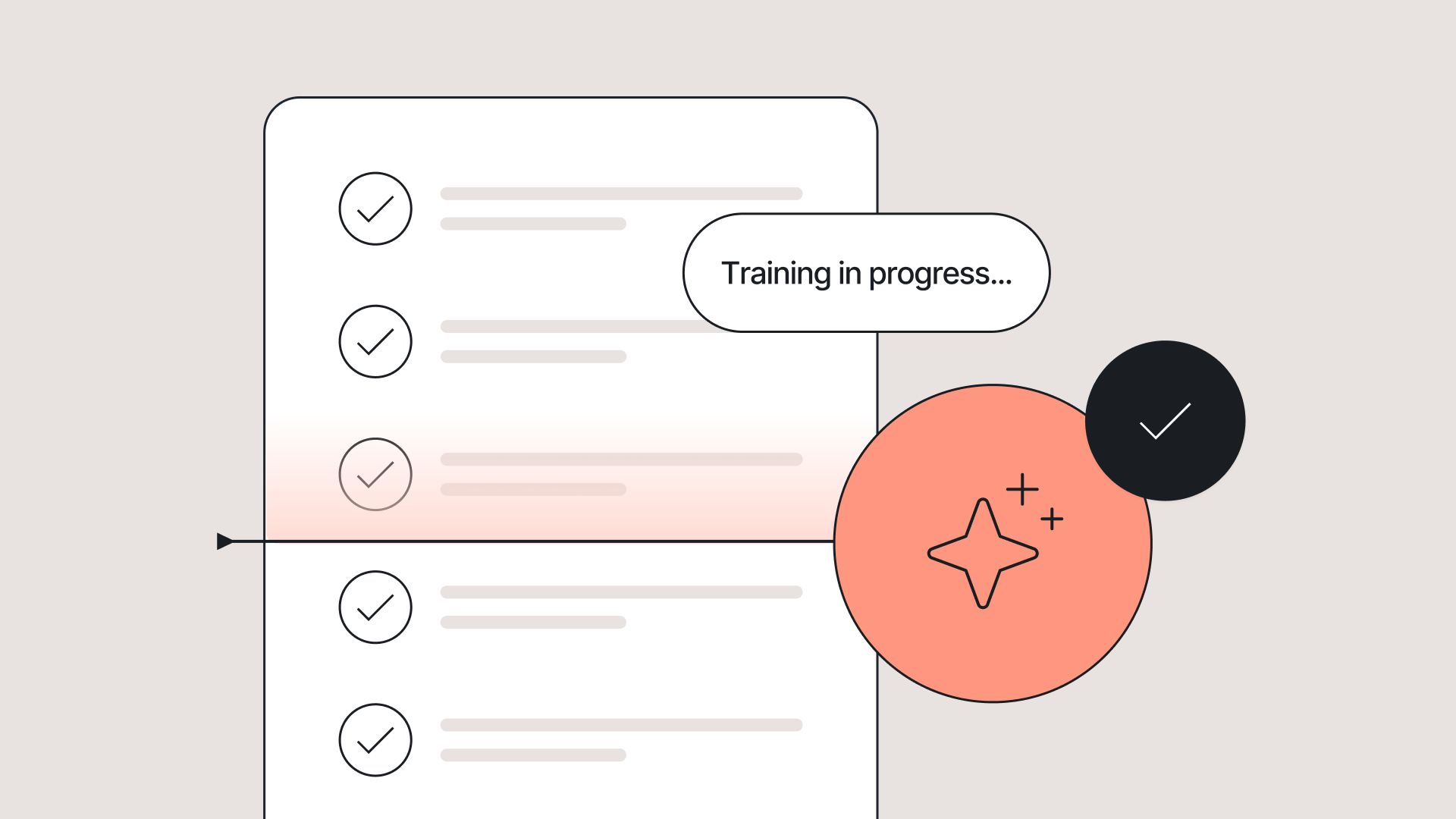
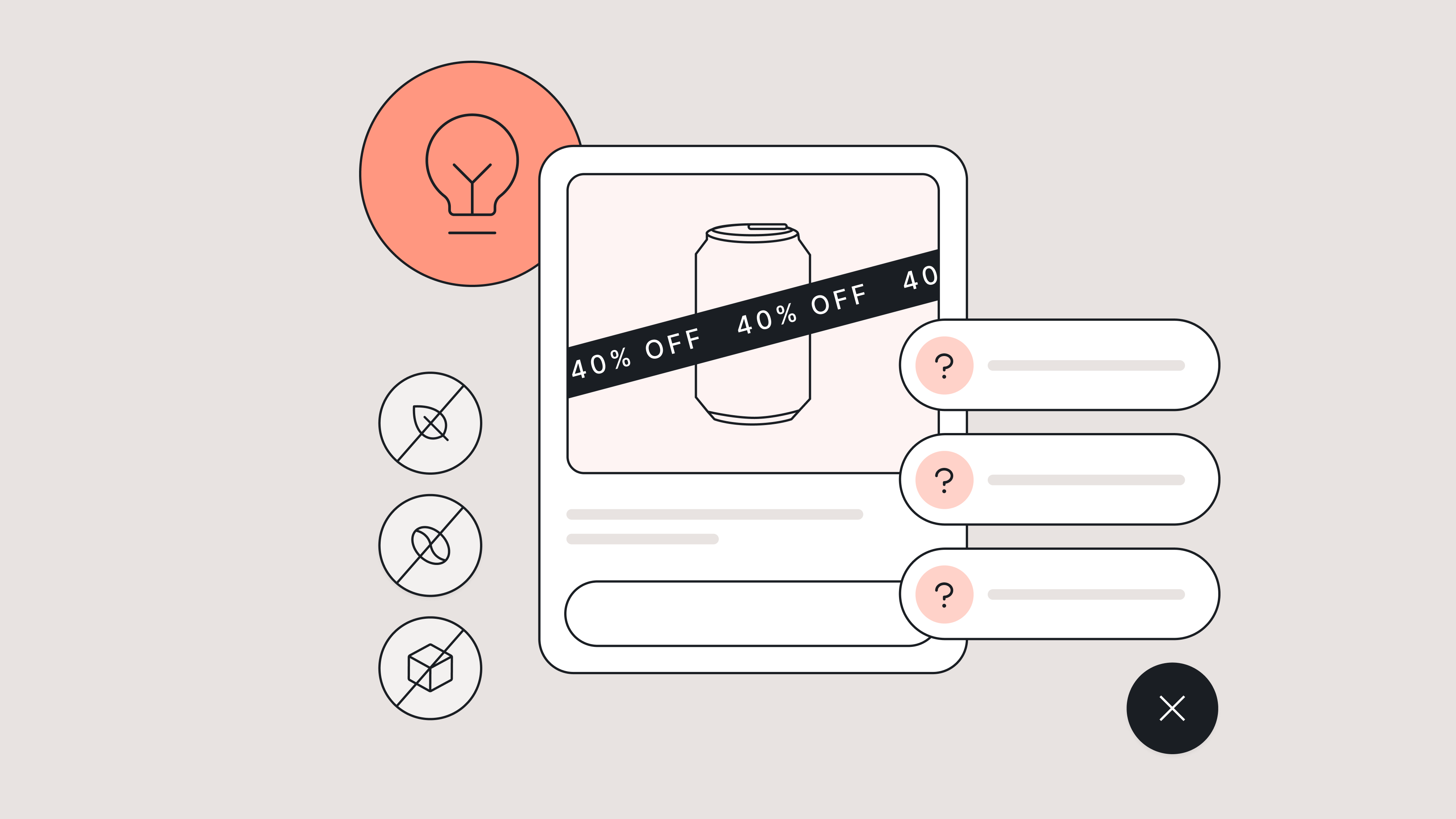

How Food & Beverage Brands Can Level Up Self-Service Before BFCM
TL;DR:
- Most food & beverage support tickets during BFCM are predictable. Subscription cancellations, WISMO, and product questions make up the bulk—so prep answers ahead of time.
- Proactive CX site updates can drastically cut down repetitive tickets. Add ingredient lists, cooking instructions, and clear refund policies to product pages and FAQs.
- FAQ pages should go deep, not just broad. Answer hyper-specific questions like “Will this break my fast?” to help customers self-serve without hesitation.
- Transparency about stock reduces confusion and cart abandonment. Show inventory levels, set up waitlists, and clearly state cancellation windows.
In 2024, Shopify merchants drove $11.5 billion in sales over Black Friday Cyber Monday. Now, BFCM is quickly approaching, with some brands and major retailers already hosting sales.
If you’re feeling late to prepare for the season or want to maximize the number of sales you’ll make, we’ll cover how food and beverage CX teams can serve up better self-serve resources for this year’s BFCM.
Learn how to answer and deflect customers’ top questions before they’re escalated to your support team.
💡 Your guide to everything peak season → The Gorgias BFCM Hub
Handling BFCM as a food & beverage brand
During busy seasons like BFCM and beyond, staying on top of routine customer asks can be an extreme challenge.
“Every founder thinks BFCM is the highest peak feeling of nervousness,” says Ron Shah, CEO and Co-founder of supplement brand Obvi.
“It’s a tough week. So anything that makes our team’s life easier instantly means we can focus more on things that need the time,” he continues.
Anticipating contact reasons and preparing methods (like automated responses, macros, and enabling an AI Agent) is something that can help. Below, find the top contact reasons for food and beverage companies in 2025.
Top contact reasons in the food & beverage industry
According to Gorgias proprietary data, the top reason customers reach out to brands in the food and beverage industry is to cancel a subscription (13%) followed by order status questions (9.1%).
Contact Reason |
% of Tickets |
|---|---|
🍽️ Subscription cancellation |
13% |
🚚 Order status (WISMO) |
9.1% |
❌ Order cancellation |
6.5% |
🥫 Product details |
5.7% |
🧃 Product availability |
4.1% |
⭐ Positive feedback |
3.9% |
7 ways to improve your self-serve resources before BFCM
- Add informative blurbs on product pages
- Craft additional help center and FAQ articles
- Automate responses with AI or Macros
- Get specific about product availability
- Provide order cancellation and refund policies upfront
- Add how-to information
- Build resources to help with buying decisions
1) Add informative blurbs on product pages
Because product detail queries represent 5.7% of contact reasons for the food and beverage industry, the more information you provide on your product pages, the better.
Include things like calorie content, nutritional information, and all ingredients.
For example, ready-to-heat meal company The Dinner Ladies includes a dropdown menu on each product page for further reading. Categories include serving instructions, a full ingredient list, allergens, nutritional information, and even a handy “size guide” that shows how many people the meal serves.

2) Craft additional Help Center and FAQ articles
FAQ pages make up the information hub of your website. They exist to provide customers with a way to get their questions answered without reaching out to you.
This includes information like how food should be stored, how long its shelf life is, delivery range, and serving instructions. FAQs can even direct customers toward finding out where their order is and what its status is.

In the context of BFCM, FAQs are all about deflecting repetitive questions away from your team and assisting shoppers in finding what they need faster.
That’s the strategy for German supplement brand mybacs.
“Our focus is to improve automations to make it easier for customers to self-handle their requests. This goes hand in hand with making our FAQs more comprehensive to give customers all the information they need,” says Alexander Grassmann, its Co-Founder & COO.
As you contemplate what to add to your FAQ page, remember that more information is usually better. That’s the approach Everyday Dose takes, answering even hyper-specific questions like, “Will it break my fast?” or “Do I have to use milk?”
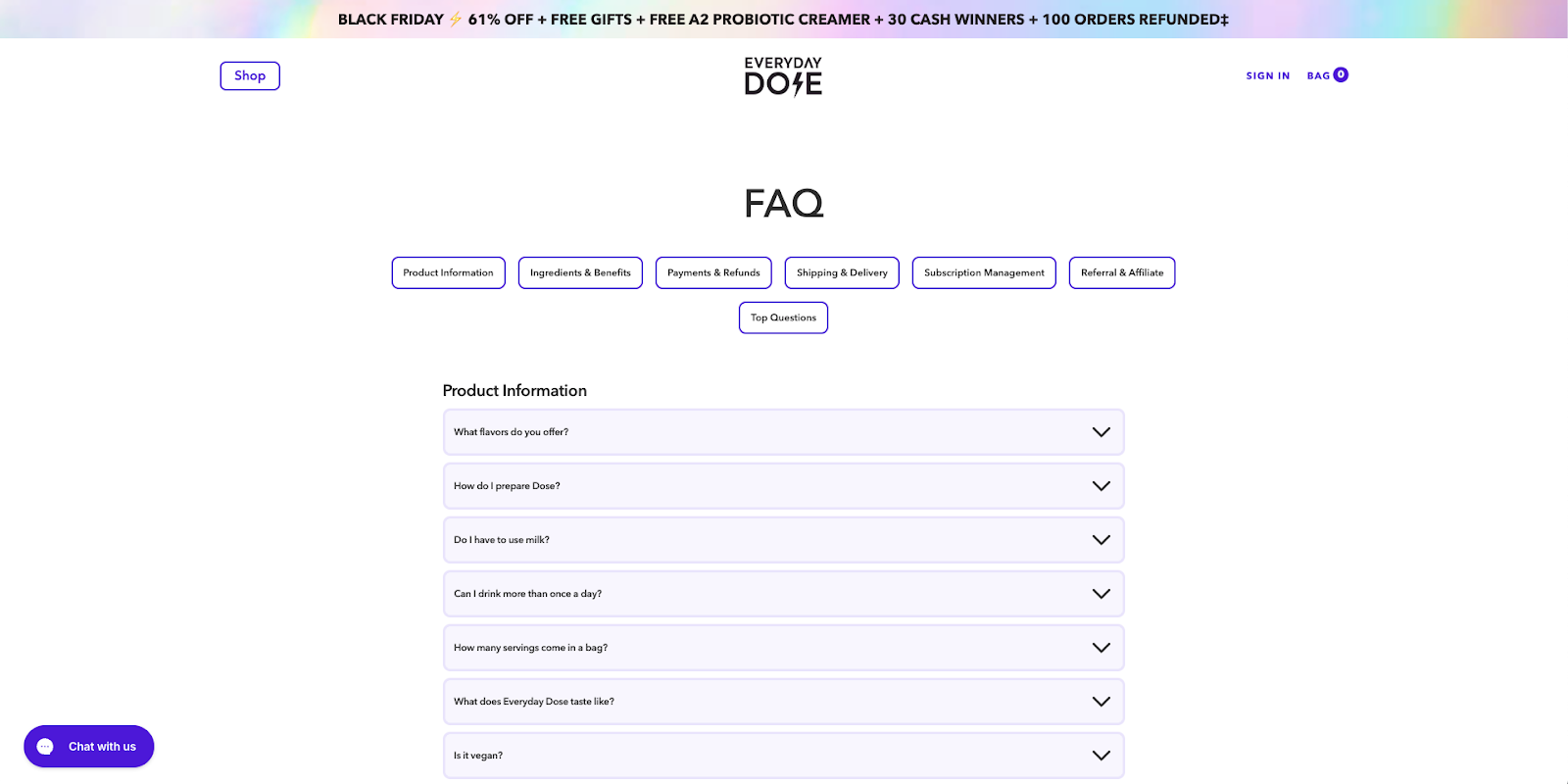
While the FAQs you choose to add will be specific to your products, peruse the top-notch food and bev FAQ pages below.
Time for some FAQ inspo:
- Juice Plus+ FAQ
- Everyday Dose FAQ
- Chamberlain Coffee FAQ
- Jurassic Fruit FAQ
- Rebel Cheese FAQ
- The Dinner Ladies FAQ
3) Automate responses with AI or macros
AI Agents and AI-powered Shopping Assistants are easy to set up and are extremely effective in handling customer interactions––especially during BFCM.
“I told our team we were going to onboard Gorgias AI Agent for BFCM, so a good portion of tickets would be handled automatically,” says Ron Shah, CEO and Co-founder at Obvi. “There was a huge sigh of relief knowing that customers were going to be taken care of.”
And, they’re getting smarter. AI Agent’s CSAT is just 0.6 points shy of human agents’ average CSAT score.
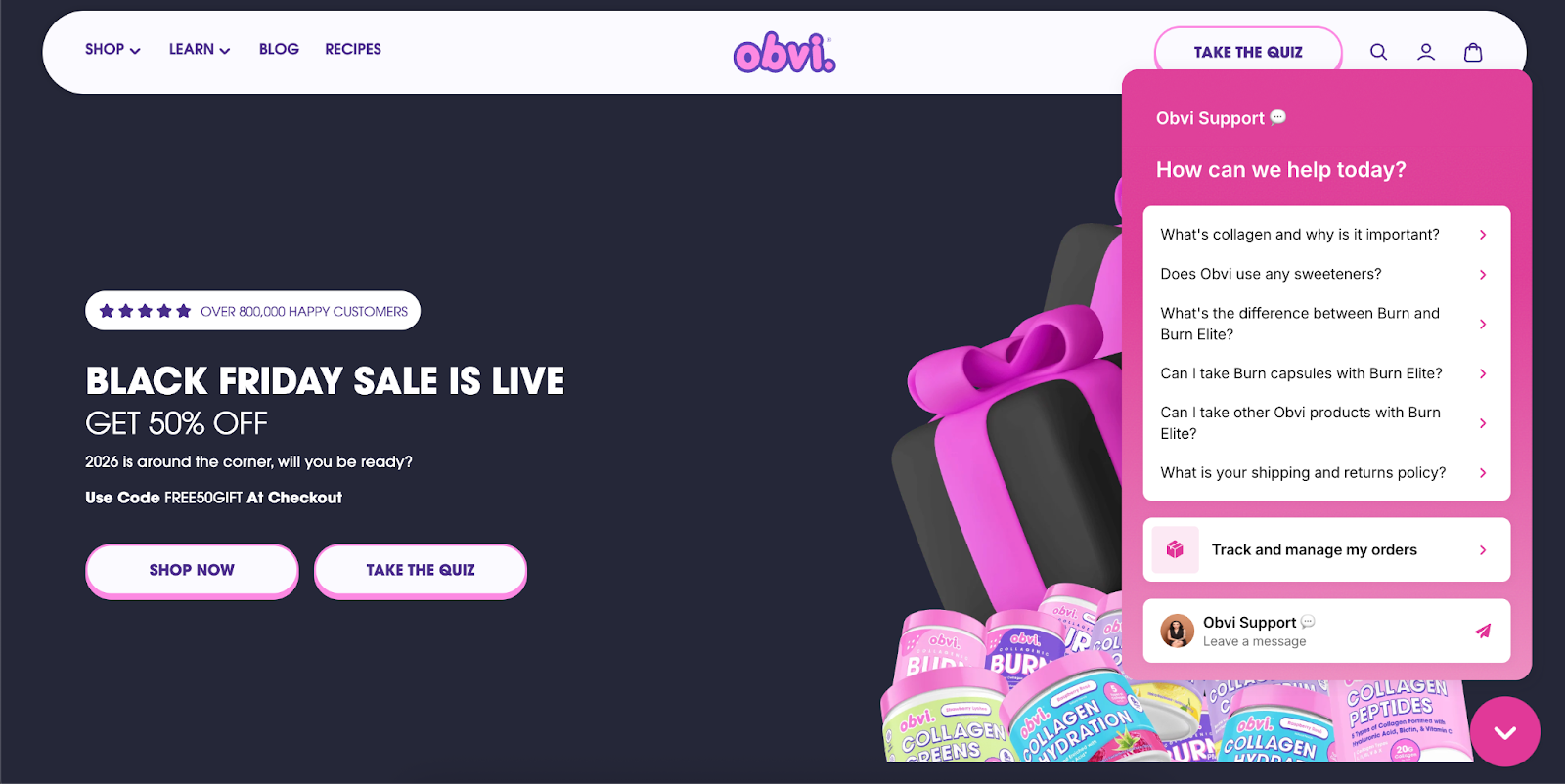
Here are the specific responses and use cases we recommend automating:
- WISMO (where is my order) inquiries
- Product related questions
- Returns
- Order issues
- Cancellations
- Discounts, including BFCM related
- Customer feedback
- Account management
- Collaboration requests
- Rerouting complex queries
Get your checklist here: How to prep for peak season: BFCM automation checklist
4) Get specific about product availability
With high price reductions often comes faster-than-usual sell out times. By offering transparency around item quantities, you can avoid frustrated or upset customers.
For example, you could show how many items are left under a certain threshold (e.g. “Only 10 items left”), or, like Rebel Cheese does, mention whether items have sold out in the past.

You could also set up presales, give people the option to add themselves to a waitlist, and provide early access to VIP shoppers.
5) Provide order cancellation and refund policies upfront
Give shoppers a heads up whether they’ll be able to cancel an order once placed, and what your refund policies are.
For example, cookware brand Misen follows its order confirmation email with a “change or cancel within one hour” email that provides a handy link to do so.
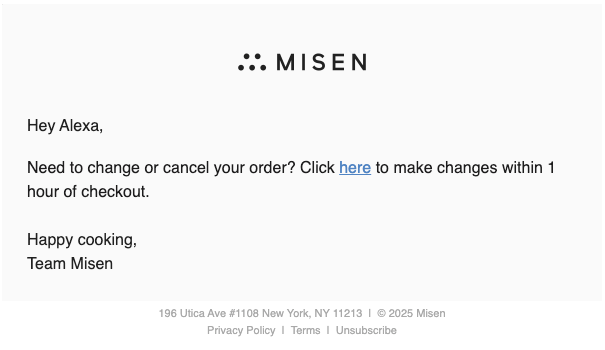
Your refund policies and order cancellations should live within an FAQ and in the footer of your website.
6) Add how-to information
Include how-to information on your website within your FAQs, on your blog, or as a standalone webpage. That might be sharing how to use a product, how to cook with it, or how to prepare it. This can prevent customers from asking questions like, “how do you use this?” or “how do I cook this?” or “what can I use this with?” etc.
For example, Purity Coffee created a full brewing guide with illustrations:
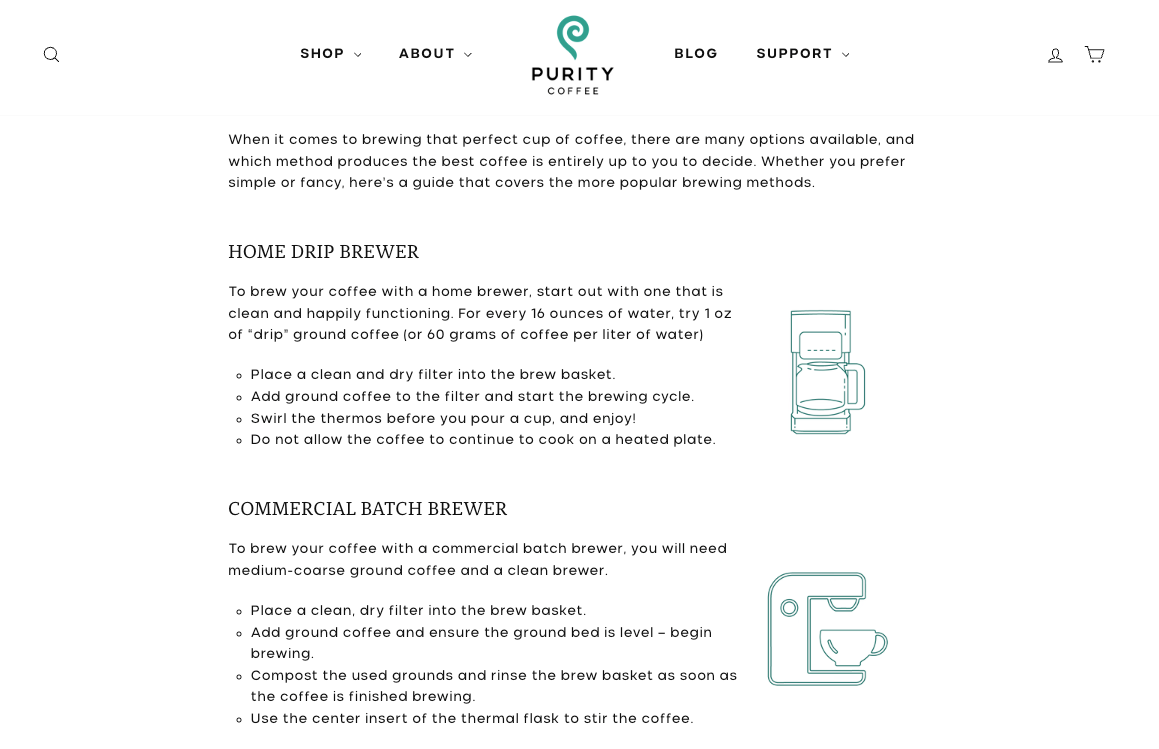
Similarly, for its unique preseasoned carbon steel pan, Misen lists out care instructions:

And for those who want to understand the level of prep and cooking time involved, The Dinner Ladies feature cooking instructions on each product page.
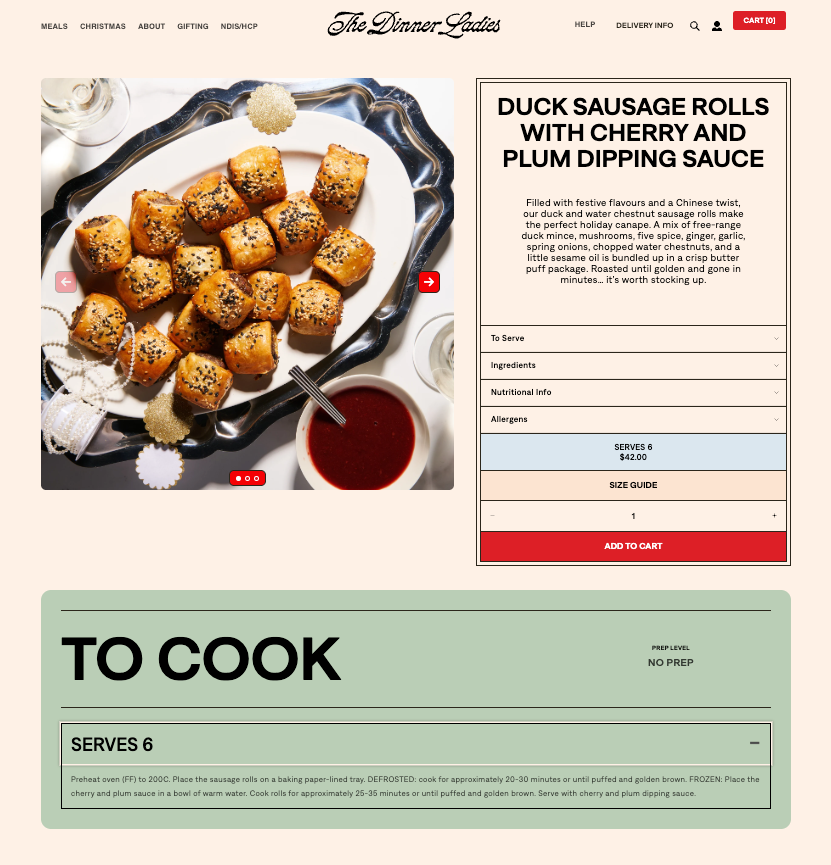
7) Build resources to help with buying decisions
Interactive quizzes, buying guides, and gift guides can help ensure shoppers choose the right items for them––without contacting you first.
For example, Trade Coffee Co created a quiz to help first timers find their perfect coffee match:
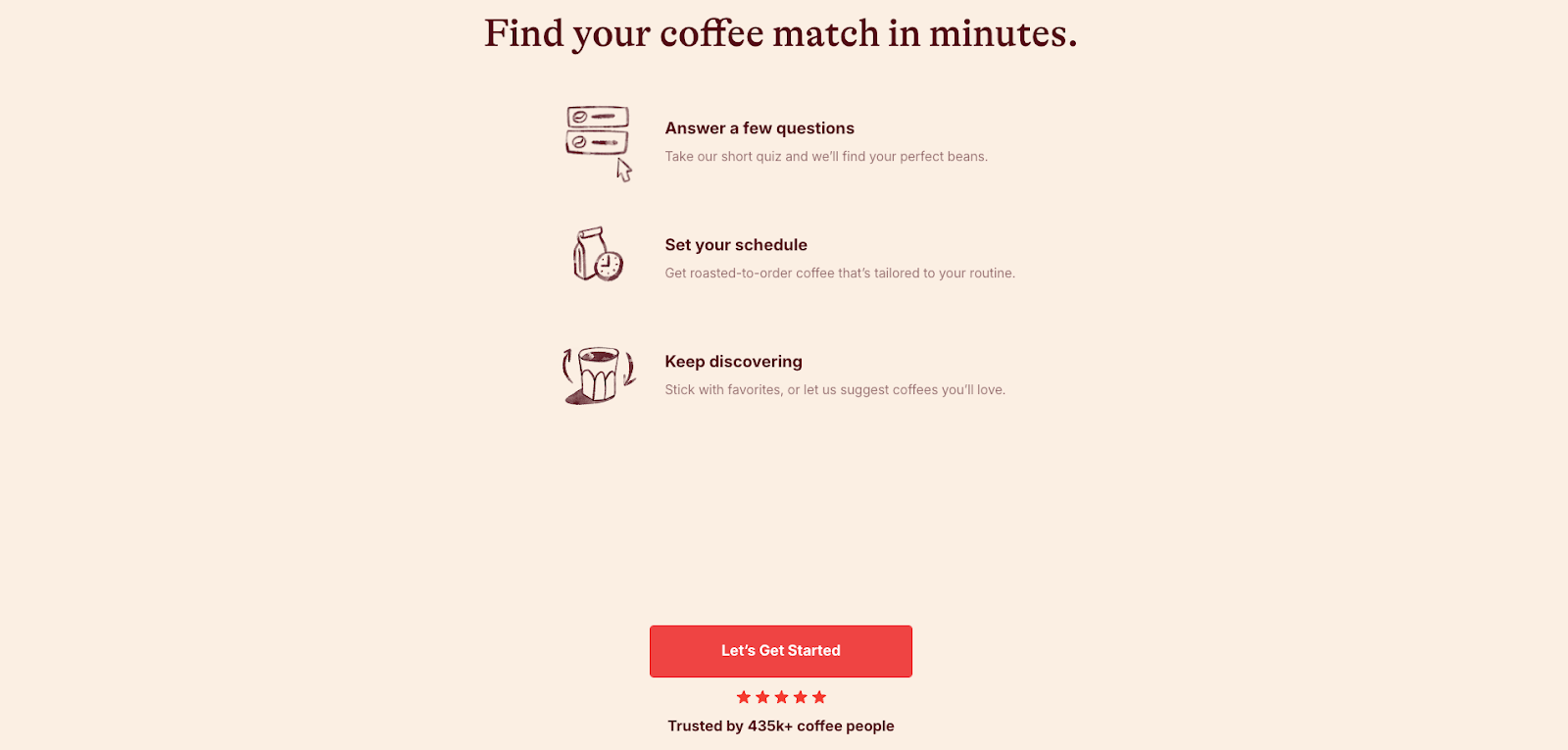
Set your team up for BFCM success with Gorgias
The more information you can share with customers upfront, the better. That will leave your team time to tackle the heady stuff.
If you’re looking for an AI-assist this season, check out Gorgias’s suite of products like AI Agent and Shopping Assistant.
{{lead-magnet-2}}
When Rhoback introduced an AI Agent to its customer experience team, it did more than automate routine tickets. Implementation revealed an opportunity to improve documentation, collaborate cross-functionally, and establish a clear brand tone of voice.
Samantha Gagliardi, Associate Director of Customer Experience at Rhoback, explains the entire process in the first episode of our AI in CX webinar series.
Key takeaways:
- Implement quickly and iterate. Rhoback’s initial rollout process took two weeks, right before BFCM. Samantha moved quickly, starting with basic FAQs and then continuously optimizing.
- Train AI like a three-year-old. Although it is empathetic, an AI Agent does not inherently know what is right or wrong. Invest in writing clear Guidance, testing responses, and ensuring document accuracy.
- Approach your AI’s tone of voice like a character study. Your AI Agent is an extension of your brand, and its personality should reflect that. Rhoback conducted a complete analysis of its agent’s tone, age, energy, and vocabulary.
- Embrace AI as a tool to reveal inconsistencies. If your AI Agent is giving inaccurate information, it’s exposing gaps in your knowledge sources. Uses these early test responses to audit product pages, help center content, Guidance, and policies.
- Check in regularly and keep humans in control. Introduce weekly reviews or QA rituals to refine AI’s accuracy, tone, and efficiency. Communicate AI insights cross-functionally to build trust and work towards shared goals.
Top learnings from Rhoback’s AI rollout
1. You can start before you “feel ready”
With any new tool, the pre-implementation phase can take some time. Creating proper documentation, training internal teams, and integrating with your tech stack are all important steps that happen before you go live.
But sometimes it’s okay just to launch a tool and optimize as you go.
Rhoback launched its AI agent two weeks before BFCM to automate routine tickets during the busy season.
Why it worked:
- Samantha had audited all of Rhoback’s SOPs, training materials, and FAQs a few months before implementation.
- They started by automating high-volume questions such as returns, exchanges, and order tracking.
- They followed a structured AI implementation checklist.
2. Audit your knowledge sources before you automate
Before turning on Rhoback’s AI Agent, Samantha’s team reviewed every FAQ, policy, and help article that human agents are trained on. This helped establish clear CX expectations that they could program into an AI Agent.
Samantha also reviewed the most frequently asked questions and the ideal responses to each. Which ones needed an empathetic human touch and which ones required fast, accurate information?
“AI tells you immediately when your data isn’t clean. If a product detail page says one thing and the help center says another, it shows up right away.”
Rhoback’s pre-implementation audit checklist:
- Review customer FAQs and the appropriate responses for each.
- Update outdated PDPs, Help Centre articles, policies, and other relevant documentation.
- Establish workflows with Ecommerce and Product teams to align Macros, Guidance, and Help Center articles with product descriptions and website copy.
Read more: How to Optimize Your Help Center for AI Agent
3. Train your AI Agent in small, clear steps
It’s often said that you should train your AI Agent like a brand-new employee.
Samantha took it one step further and recommended treating AI like a toddler, with clear, patient, repetitive instructions.
“The AI does not have a sense of good and bad. It’s going to say whatever you train it, so you need to break it down like you’re talking to a three-year-old that doesn’t know any different. Your directions should be so detailed that there is no room for error.”
Practical tips:
- Use AI to build your AI Guidance, focusing on clear, detailed, simple instructions.
- Test each Guidance before adding new ones.
- Treat the training process like an ongoing feedback loop, not a one-time upload.
Read more: How to Write Guidance with the “When, If, Then” Framework
4. Prioritize Tone of Voice to make AI feel natural
For Rhoback, an on-brand Tone of Voice was a non-negotiable. Samantha built a character study that shaped Rhoback’s AI Agent’s custom brand voice.
“I built out the character of Rhoback, how it talks, what age it feels like, what its personality is. If it does not sound like us, it is not worth implementing.”
Key questions to shape your AI Agent’s tone of voice:
- How does the AI Agent speak? Friendly, funny, empathetic, etc…?
- Does your AI Agent use emojis? How often?
- Are there any terms or phrases the AI Agent should always or never say?
5. Use AI to surface knowledge gaps or inconsistencies
Once Samantha started testing the AI Agent, it quickly revealed misalignment between Rhoback’s teams. With such an extensive product catalog, AI showed that product details did not always match the Help Center or CX documentation.
This made a case for stronger collaboration amongst the CX, Product, and Ecommerce teams to work towards their shared goal of prioritizing the customer.
“It opened up conversations we were not having before. We all want the customer to be happy, from the moment they click on an ad to the moment they purchase to the moment they receive their order. AI Agent allowed us to see the areas we need to improve upon.”
Tips to improve internal alignment:
- Create regular syncs between CX, Product, Ecommerce, and Marketing teams.
- Share AI summaries, QA insights, and trends to highlight recurring customer pain points.
- Build a collaborative workflow for updating documents that gives each team visibility.
6. Build trust (with your team and customers) through transparency
Despite the benefits of AI for CX, there’s still trepidation. Agents are concerned that AI would replace them, while customers worry they won’t be able to reach a human. Both are valid concerns, but clearly communicating internally and externally can mitigate skepticism.
At Rhoback, Samantha built internal trust by looping in key stakeholders throughout the testing process. “I showed my team that it is not replacing them. It’s meant to be a support that helps them be even more successful with what they’re already doing," Samantha explains.
On the customer side, Samantha trained their AI Agent to tell customers in the first message that it is an AI customer service assistant that will try to help them or pass them along to a human if it can’t.
How Rhoback built AI confidence:
- Positioned AI as a personal assistant for agents, not a replacement.
- Let agents, other departments, and leadership test and shape the AI Agent experience early.
- Told customers up front when automation was being used and made the path to a human clear and easy.
Read more: How CX Leaders are Actually Using AI: 6 Must-Know Lessons
Putting these into practice: Rhoback’s framework for an aligned AI implementation
Here is Rhoback’s approach distilled into a simple framework you can apply.
- Audit your content: Ensure your FAQs, product data, policies, and all documentation are accurate.
- Start small: Automate one repetitive workflow, such as returns or tracking.
- Train iteratively: Add Guidance in small, testable batches.
- Prioritize tone: Make sure every AI reply sounds like your brand.
- Align teams: Use AI data to resolve cross-departmental inconsistencies and establish clearer communication lines.
- Be transparent: Tell both agents and customers how AI fits into the process.
- Refine regularly: Review, measure, and adjust on an ongoing basis.
Watch the full conversation with Samantha to learn how AI can act as a catalyst for better internal alignment.
📌 Join us for episode 2 of AI in CX: Building a Conversational Commerce Strategy that Converts with Cornbread Hemp on December 16.
{{lead-magnet-1}}
TL;DR:
- You don’t need to rebuild your Help Center to make it work with AI—you just need to structure it smarter.
- AI Agent reads your content in three layers: Help Center, Guidance, and Actions, following an “if / when / then” logic to find and share accurate answers.
- Most AI escalations happen because Help Docs are vague or incomplete. Start by improving your top 10 ticket topics—like order status, returns, and refunds.
- Make your articles scannable, define clear conditions, link next steps, and keep your tone consistent. These small tweaks help AI Agent resolve more tickets on its own—and free up your team to focus on what matters most.
As holiday season support volumes spike and teams lean on AI to keep up, one frustration keeps surfacing, our Help Center has the answers—so why can’t AI find them?
The truth is, AI can’t help customers if it can’t understand your Help Center. Most large language models (LLMs), including Gorgias AI Agent, don’t ignore your existing docs, they just struggle to find clear, structured answers inside them.
The good news is you don’t need to rebuild your Help Center or overhaul your content. You simply need to format it in a way that’s easy for both people and AI to read.
We’ll break down how AI Agent reads your Help Center, finds answers, and why small formatting changes can help it respond faster and more accurately, so your team spends less time on escalations.
{{lead-magnet-1}}
How AI Agent uses your Help Center content
Before you start rewriting your Help Center, it helps to understand how AI Agent actually reads and uses it.
Think of it like a three-step process that mirrors how a trained support rep thinks through a ticket.
1. Read Help Center docs
Your Help Center is AI Agent’s brain. AI Agent uses your Help Center to pull facts, policies, and instructions it needs to respond to customers accurately. If your articles are clearly structured and easy to scan, AI Agent can find what it needs fast. If not, it hesitates or escalates.
2. Follow Guidance instructions
Think of Guidance as AI Agent’s decision layer. What should AI Agent do when someone asks for a refund? What about when they ask for a discount? Guidance helps AI Agent provide accurate answers or hand over to a human by following an “if/when/then” framework.
3. Respond and perform
Finally, AI Agent uses a combination of your help docs and Guidance to respond to customers, and if enabled, perform an Action on their behalf—whether that’s changing a shipping address or canceling an order altogether.
Here’s what that looks like in practice:
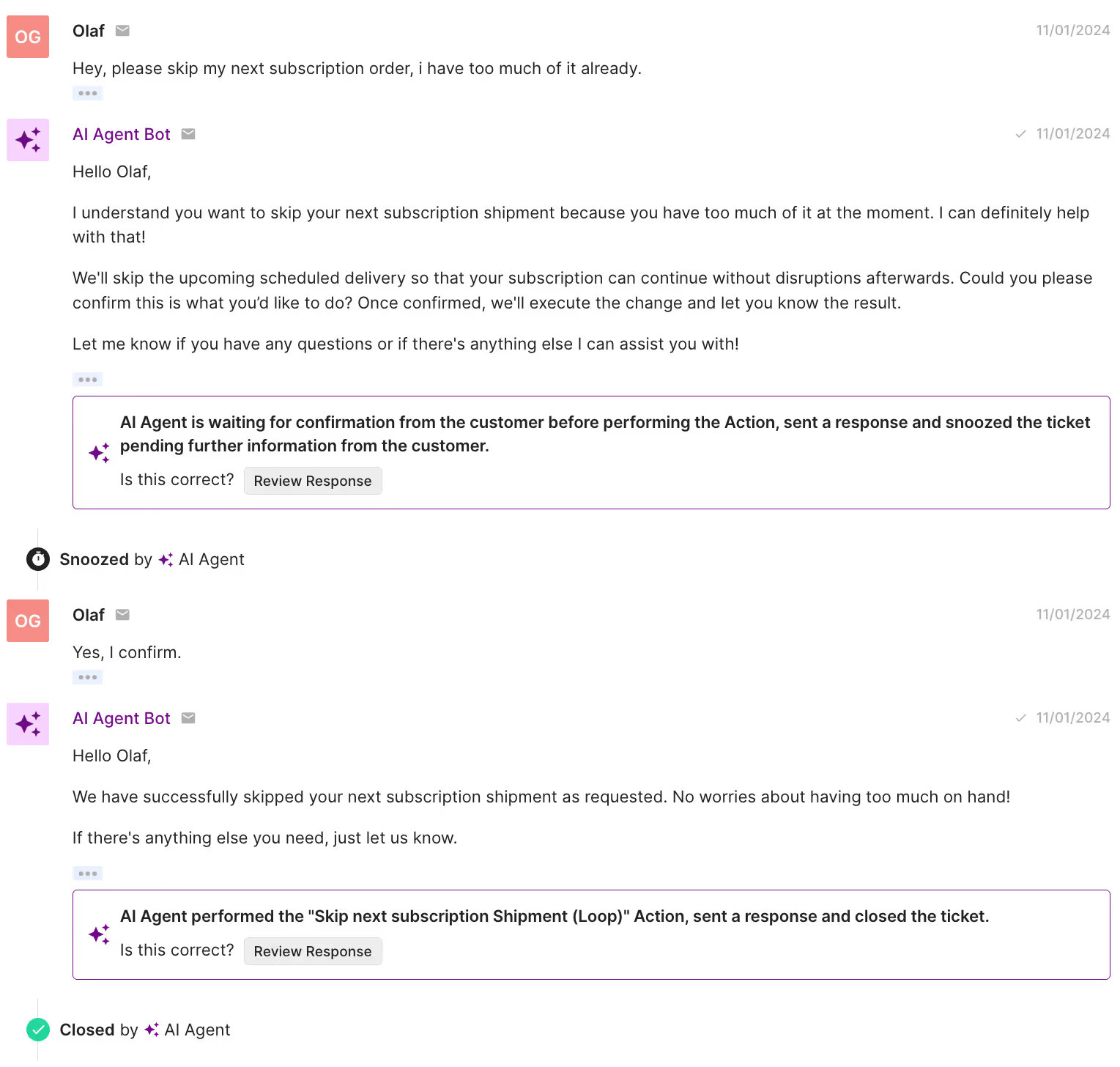
This structure removes guesswork for both your AI and your customers. The clearer your docs are about when something applies and what happens next, the more accurate and human your automated responses will feel.
A Help Center written for both people and AI Agent:
- Saves your team time
- Reduces escalations
- Helps every customer get the right answer the first time
What causes AI Agent to escalate tickets, and how to fix it
Our data shows that most AI escalations happen for a simple reason––your Help Center doesn’t clearly answer the question your customer is asking.
That’s not a failure of AI. It’s a content issue. When articles are vague, outdated, or missing key details, AI Agent can’t confidently respond, so it passes the ticket to a human.
Here are the top 10 topics that trigger escalations most often:
Rank |
Ticket Topic |
% of Escalations |
|---|---|---|
1 |
Order status |
12.4% |
2 |
Return request |
7.9% |
3 |
Order cancellation |
6.1% |
4 |
Product - quality issues |
5.9% |
5 |
Missing item |
4.6% |
6 |
Subscription cancellation |
4.4% |
7 |
Order refund |
4.1% |
8 |
Product details |
3.5% |
9 |
Return status |
3.3% |
10 |
Order delivered but not received |
3.1% |
Each of these topics needs a dedicated, clearly structured Help Doc that uses keywords customers are likely to search and spells out specific conditions.
Here’s how to strengthen each one:
- Order status: Include expected delivery timelines, tracking link FAQs, and a clear section for “what to do if tracking isn’t updating.”
- Return request: Spell out eligibility requirements, time limits, and how to print or request a return label.
- Order cancellation: Define cut-off times for canceling and link to your “returns” doc for shipped orders.
- Product quality issues: Explain what qualifies as a defect, how to submit photos, and whether replacements or refunds apply.
- Missing item: Clarify how to report missing items and what verification steps your team takes before reshipping.
- Subscription cancellation: Add “if/then” logic for different cases: if paused vs. canceled, if prepaid vs. monthly.
- Order refund: Outline refund timelines, where customers can see status updates, and any exceptions (e.g., partial refunds).
- Product details: Cover sizing, materials, compatibility, or FAQs that drive most product-related questions.
- Return status: State how long returns take to process and where to check progress once a label is scanned.
- Order delivered but not received: Provide step-by-step guidance for checking with neighbors, filing claims, or requesting replacements.
Start by improving these 10 articles first. Together, they account for nearly half of all AI Agent escalations. The clearer your Help Center is on these topics, the fewer tickets your team will ever see, and the faster your AI will resolve the rest.
How to format your Help Center docs for LLMs
Once you know how AI Agent reads your content, the next step is formatting your help docs so it can easily understand and use them.
The goal isn’t to rewrite everything, it’s to make your articles more structured, scannable, and logic-friendly.
Here’s how.
1. Use structured, scannable sections
Both humans and large language models read hierarchically. If your article runs together in one long block of text, key answers get buried.
Break articles into clear sections and subheadings (H2s, H3s) for each scenario or condition. Use short paragraphs, bullets, and numbered lists to keep things readable.
Example:
How to Track Your Order
- Step 1: Find your tracking number in your confirmation email.
- Step 2: Click the tracking link to see your delivery status.
- Step 3: If tracking hasn’t updated in 3 days, contact support.
A structured layout helps both AI and shoppers find the right step faster, without confusion or escalation.
2. Write for “if/when/then” logic
AI Agent learns best when your Help Docs clearly define what happens under specific conditions. Think of it like writing directions for a flowchart.
Example:
- “If your order hasn’t arrived within 10 days, contact support for a replacement.”
- “If your order has shipped, you can find the tracking link in your order confirmation email.”
This logic helps AI know what to do and how to explain the answer clearly to the customer.
3. Clarify similar terms and synonyms
Customers don’t always use the same words you do, and neither do LLMs. If your docs treat “cancel,” “stop,” and “pause” as interchangeable, AI Agent might return the wrong answer.
Define each term clearly in your Help Center and add small keyword variations (“cancel subscription,” “end plan,” “pause delivery”) so the AI can recognize related requests.
4. Link to next steps
AI Agent follows links just like a human agent. If your doc ends abruptly, it can’t guide the customer any further.
Always finish articles with an explicit next step, like linking to:
- A form
- Another article
- A support action page
Example: “If your return meets our policy, request your return label here.”
That extra step keeps the conversation moving and prevents unnecessary escalations.
5. Keep tone consistent
AI tools prioritize structure and wording when learning from your Help Center—not emotional tone.
Phrases like “Don’t worry!” or “We’ve got you!” add noise without clarity.
Instead, use simple, action-driven sentences that tell the customer exactly what to do:
- “Click here to request a refund.”
- “Fill out the warranty form to get a replacement.”
A consistent tone keeps your Help Center professional, helps AI deliver reliable responses, and creates a smoother experience for customers.
LLM-friendly Help Centers in action
You don’t need hundreds of articles or complex workflows to make your Help Center AI-ready. But you do need clarity, structure, and consistency. These Gorgias customers show how it’s done.
Little Words Project: Simple formatting that boosts instant answers
Little Words Project keeps things refreshingly straightforward. Their Help Center uses short paragraphs, descriptive headers, and tightly scoped articles that focus on a single intent, like returns, shipping, or product care.
That makes it easy for AI Agent to scan the page, pull out the right facts, and return accurate answers on the first try.
Their tone stays friendly and on-brand, but the structure is what shines. Every article flows from question → answer → next step. It’s a minimalist approach, and it works. Both for customers and the AI reading alongside them.
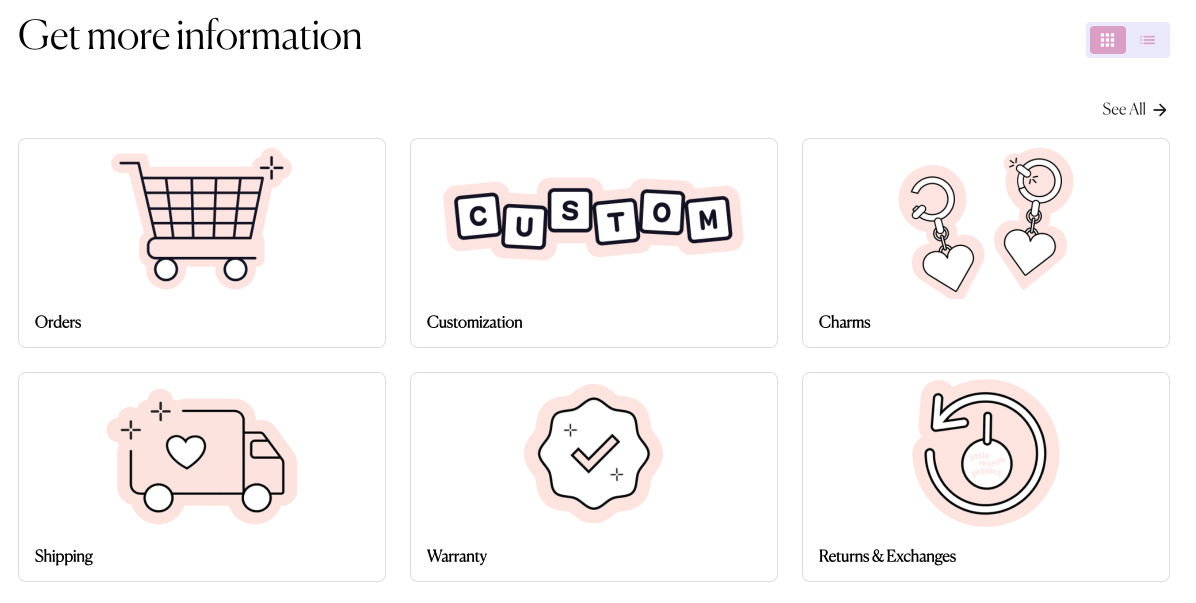
Dr. Bronner’s: Making tools work for the team
Customer education is at the heart of Dr. Bronner’s mission. Their customers often ask detailed questions about product ingredients, packaging, and certifications. With Gorgias, Emily and her team were able to build a robust Help Center that helped to proactively give this information.
The Help Center doesn't just provide information. The integration of interactive Flows, Order Management, and a Contact Form automation allowed Dr. Bronner’s to handle routine inquiries—such as order statuses—quickly and efficiently. These kinds of interactive elements are all possible out-of-the-box, no IT support needed.
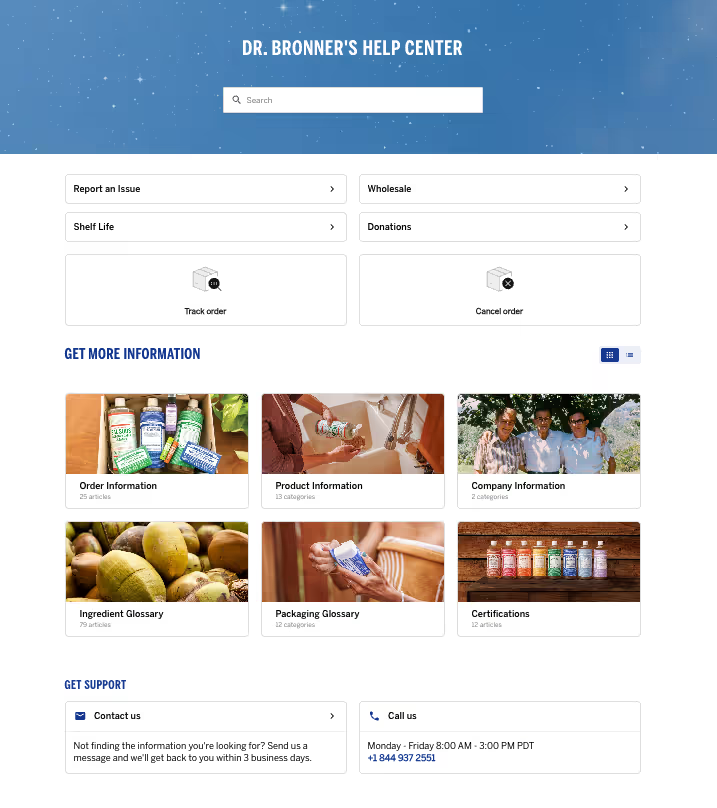
Ekster: Building efficiency through automation and clarity

When Ekster switched to Gorgias, the team wanted to make their Help Center work smarter. By writing clear, structured articles for common questions like order tracking, returns, and product details, they gave both customers and AI Agent the information needed to resolve issues instantly.
"Our previous Help Center solution was the worst. I hated it. Then I saw Gorgias’s Help Center features, and how the Article Recommendations could answer shoppers’ questions instantly, and I loved it. I thought: this is just what we need." —Shauna Cleary, Head of Ecommerce at Ekster
The results followed fast. With well-organized Help Center content and automation built around it, Ekster was able to scale support without expanding the team.
“With all the automations we’ve set up in Gorgias, and because our team in Buenos Aires has ramped up, we didn’t have to rehire any extra agents.” —Shauna Cleary, Head of Ecommerce at Ekster
Learn more: How Ekster used automation to cover the workload of 4 agents
Rowan: Clean structure that keeps customers (and AI) on track
Rowan’s Help Center is a great example of how clear structure can do the heavy lifting. Their FAQs are grouped into simple categories like piercing, shipping, returns, and aftercare, so readers and AI Agent can jump straight to the right topic without digging.
For LLMs, that kind of consistency reduces guesswork. For customers, it creates a smooth, reassuring self-service experience.
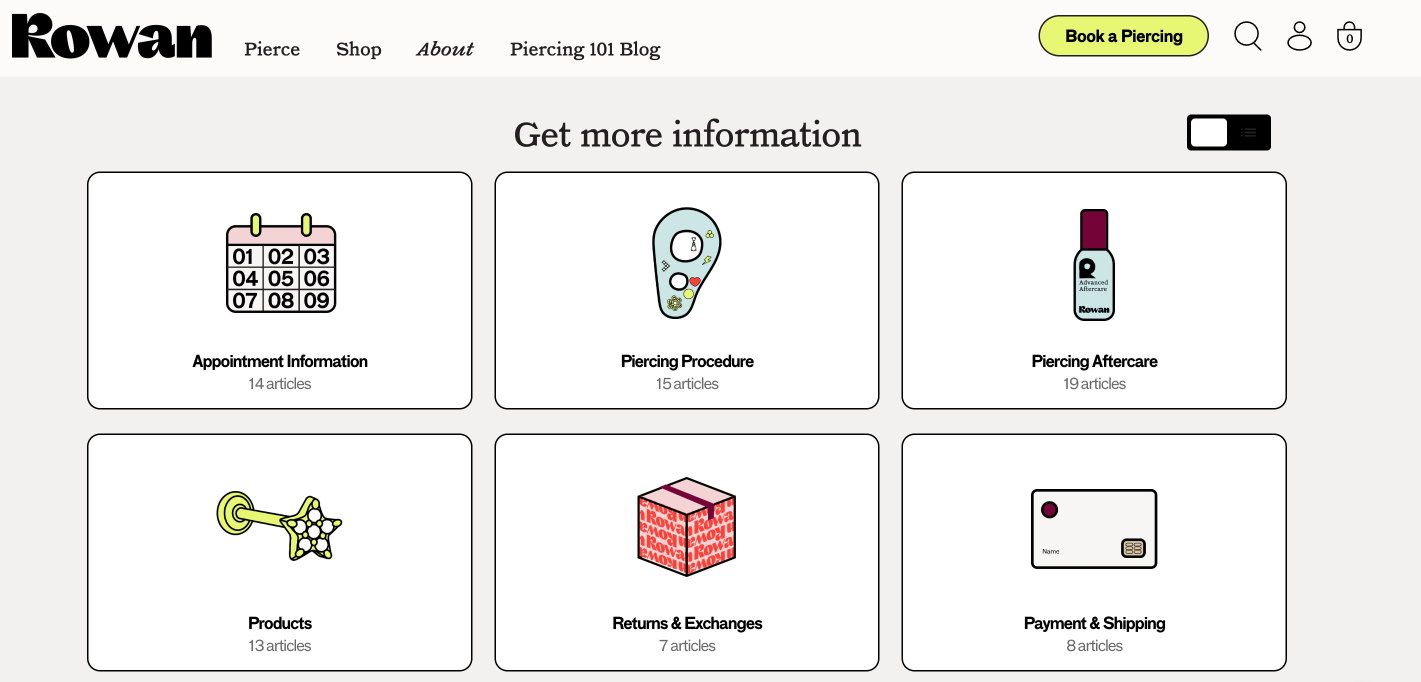
TUSHY: Balancing brand voice with automation
TUSHY proves you can maintain personality and structure. Their Help Center articles use clear headings, direct language, and brand-consistent tone. It makes it easy for AI Agent to give accurate, on-brand responses.
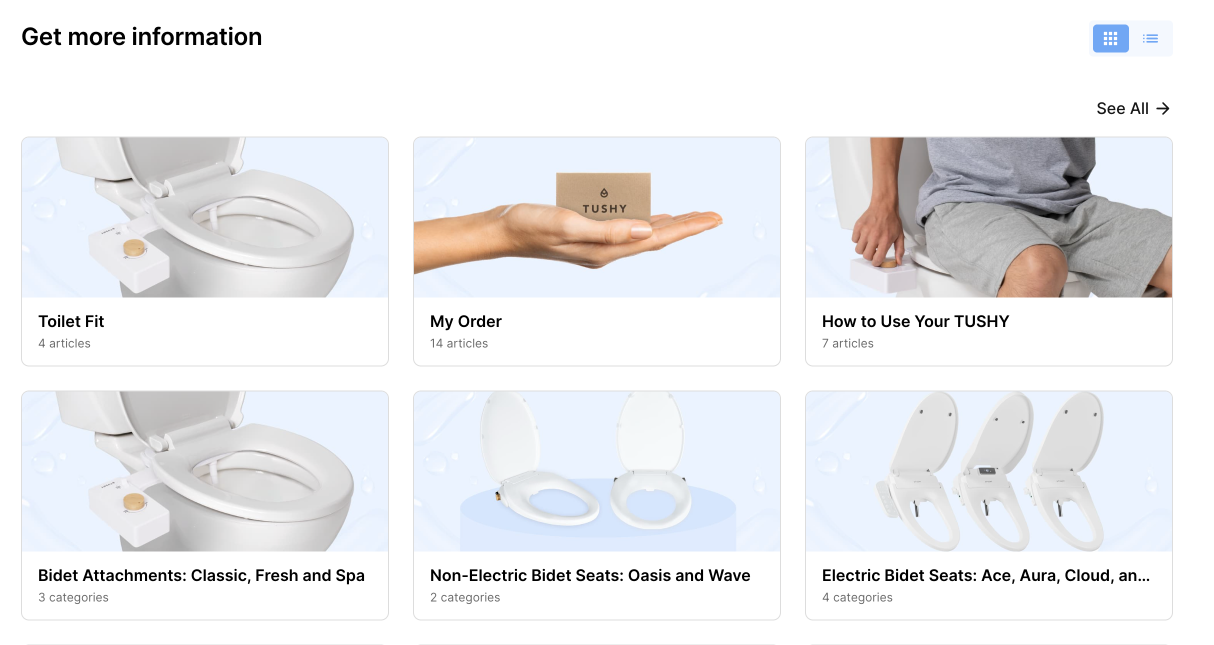
“Too often, a great interaction is diminished when a customer feels reduced to just another transaction. With AI, we let the tech handle the selling, unabashedly, if needed, so our future customers can ask anything, even the questions they might be too shy to bring up with a human. In the end, everybody wins!" —Ren Fuller-Wasserman, Senior Director of Customer Experience at TUSHY
Quick checklist to audit your Help Center for AI
Ready to put your Help Center to the test? Use this five-point checklist to make sure your content is easy for both customers and AI to navigate.
1. Are your articles scannable with clear headings?
Break up long text blocks and use descriptive headers (H2s, H3s) so readers and AI Agent can instantly find the right section.
2. Do you define conditions with “if/when/then” phrasing?
Spell out what happens in each scenario. This logic helps AI Agent decide the right next step without second-guessing.
3. Do you cover your top escalation topics?
Make sure your Help Center includes complete, structured articles for high-volume issues like order status, returns, and refunds.
4. Does each article end with a clear next step or link?
Close every piece with a call to action, like a form, related article, or support link, so neither AI nor customers hit a dead end.
5. Is your language simple, action-based, and consistent?
Use direct, predictable phrasing. Avoid filler like “Don’t worry!” and focus on steps customers can actually take.
By tweaking structure instead of your content, it’s easier to turn your Help Center into a self-service powerhouse for both customers and your AI Agent.
Make your Help Center work smarter
Your Help Center already holds the answers your customers need. Now it’s time to make sure AI can find them. A few small tweaks to structure and phrasing can turn your existing content into a powerful, AI-ready knowledge base.
If you’re not sure where to start, review your Help Center with your Gorgias rep or CX team. They can help you identify quick wins and show you how AI Agent pulls information from your articles.
Remember: AI Agent gets smarter with every structured doc you publish.
Ready to optimize your Help Center for faster, more accurate support? Book a demo today.
{{lead-magnet-2}}
Newsletter Signup
The best in CX and ecommerce, right to your inbox
Featured articles

How to Prep for Peak Season: BFCM Automation Checklist
TL;DR:
- Start by cleaning up your Help Center. Update your articles based on last year’s data, using plain language and clear policy details to boost self-service.
- Use automations to streamline ticket routing and support efficiency. Set rules for tagging, escalation, and inbox views, so your team can respond faster.
- Prep your macros, AI, and staffing plan in advance. Build responses for top FAQs, train AI on the right sources, and forecast agent needs to avoid burnout.
- Automate logistics, upselling, and QA to stay ahead. From showing shipping timelines to flagging low-quality responses, automation ensures smooth operations and more revenue during peak season.
Getting ready for that yearly ticket surge isn’t only about activating every automation feature on your helpdesk, it’s about increasing efficiency across your entire support operations.
This year, we’re giving you one less thing to worry about with our 2025 BFCM automation guide. Whether your team needs a tidier Help Center or better ticket routing rules, we’ve got a checklist for every area of the customer experience brought to you by top industry players, including ShipBob, Loop Returns, TalentPop, and more.
{{lead-magnet-1}}
2025 BFCM automation checklist
- Tidy up your Help Center
- Audit your docs
- Review last year’s BFCM data to find your must-have articles
- Update your policy details
- Edit content using easy-to-understand language
- Expedite your ticket routing automations
- Set up automated ticket tags
- Create an inbox view for each category
- Set escalation rules for urgent tickets
- Set up mandatory Ticket Fields
- Prep your macros and AI agent
- Write macros for your top FAQs
- Train your AI on the right sources
- Define the limits of what AI should handle
- Forecast your BFCM staffing needs
- Use ticket volume to estimate the number of agents
- Plan extra coverage with automation or outsourcing
- Run agent training sessions on BFCM protocols
- Map out your logistics processes
- Negotiate better rates and processing efficiencies
- Automate inventory reorder points
- Build contingency plans for disruptions
- Show shipping timelines on product pages
- Maximize profits with upselling automations
- Guide shoppers with smart recommendations
- Suggest alternatives when items are out of stock
- Engage hesitant shoppers with winback discounts
- Keep support quality high with QA automations
- Automate ticket reviews with AI-powered QA
- Track both agent and AI responses
- Turn QA insights into coaching opportunities
Tidy up your Help Center
Your customer knowledge base, FAQs, or Help Center is a valuable hub of answers for customers’ most asked questions. For those who prefer to self-serve, it’s one of the first resources they visit. To ensure customers get accurate answers, do the following:
- Audit your docs
- Review last year’s BFCM data to find your must-have articles
- Update your policy details
- Edit content using easy-to-understand language
1. Audit your docs
Take stock of what’s currently in your database. Are you still displaying low-engagement or unhelpful articles? Are articles about discontinued products still up? Start by removing outdated content first, and then decide which articles to keep from there.
Related: How to refresh your Help Center: A step-by-step guide
2. Review last year’s BFCM data to find your must-have articles
Are you missing key topics, or don’t have a database yet? Look at last year’s tickets. What were customers’ top concerns? Were customers always asking about returns? Was there an uptick in free shipping questions? If an inquiry repeats itself, it’s a sign to add it to your Help Center.
3. Update your policy details
An influx of customers means more people using your shipping, returns, exchanges, and discount policies. Make sure these have accurate information about eligibility, conditions, and grace periods, so your customers have one reliable source of truth.
Personalization tip: Loop Returns advises adjusting your return policy for different return reasons. With Loop’s Workflows, you can automatically determine which customers and which return reasons should get which return policies.
Read more: Store policies by industry, explained: What to include for every vertical
4. Edit content using easy-to-understand language
Customers want fast answers, so ensure your docs are easy to read and understand. Titles and answers should be clear. Avoid technical jargon and stick to simple sentences that express one idea. To accelerate the process, use AI tools like Grammarly and ChatGPT.
No time to set up a Help Center? Gorgias automatically generates Help Center articles for you based on what people are asking in your inbox.

Expedite your ticket routing automations
Think of ticket routing like running a city. Cars are your tickets (and customers), roads are your inboxes, and traffic lights are your automations and rules. The better you maintain these structures, the better they can run on their own without needing constant repairs from your CX team.
Here’s your ticket routing automation checklist:
- Tag every ticket
- Create views for each category you need (VIP, Returns, Troubleshooting, etc.)
- Set escalation rules for urgent tickets
- Set up mandatory Ticket Fields
1. Set up automated ticket tags
Instead of asking agents to tag every ticket, set rules that apply tags based on keywords, order details, or message type. A good starting point is to tag tickets by order status, returns, refunds, VIP customers, and urgent issues so your team can prioritize quickly.
Luckily, many helpdesks offer AI-powered tags or contact reasons to reduce manual work. For example, Gorgias automatically detects a ticket’s Contact Reason. The system learns from past interactions, tagging your tickets with more accuracy each time.

2. Create an inbox view for each category
Custom or filtered inbox views give your agents a filtered and focused workspace. Start with essential views like VIP customers, returns, and damages, then add specialized views that match how your team works.
If you’re using conversational AI to answer tickets, views become even more powerful. For example, you might track low CSAT tickets to catch where AI responses fall short or high handover rates to identify AI knowledge gaps. The goal is to reduce clutter so agents can focus on delivering support.
3. Set escalation rules for urgent tickets
Don’t get bogged down in minor issues while urgent tickets sit unanswered. Escalation rules make sure urgent cases are pushed to the top of your inbox, so they don’t risk revenue or lead to unhappy customers.
Tickets to escalate to agents or specialized queues:
- Lost packages
- Damaged items
- Defective items
- Failed payments
- Open tickets without a follow-up
4. Set up mandatory Ticket Fields to get data right off the bat
Ticket Fields add structure by requiring your team to capture key data before closing a ticket. For BFCM, make fields like Contact Reason, Resolution, and Return Reason mandatory so you always know why customers reached out and how the issue was resolved.
For CX leads, Ticket Fields removes guesswork. Instead of sifting through tickets one by one, you’ll have clean data to spot trends, report on sales drivers, and train your team.
Pro Tip: Use conditional fields to dig deeper without overwhelming agents. For example, if the contact reason is “Return,” automatically prompt the agent to log the return reason or product defect.
Prep your macros and AI agent
Macros and AI Agent are your frontline during BFCM. When prepped properly, they can clear hundreds of repetitive tickets. The key is to ensure that answers are accurate, up-to-date, and aligned with what you want AI to handle.
- Write macros for your most common FAQs
- Train your AI on the right sources
- Define the limits of what AI should handle
1. Write macros for your top FAQs
Customers will flood your inbox with the same questions: “Where’s my order?” “When will my discount apply?” “What’s your return policy?” Write macros that give short, direct answers up front, include links for details, and use placeholders for personalization.
Bad macro:
- “You can track your order with the tracking link. It should update soon.”
Good macro:
- “Hi {{customer_firstname}}, you can track your order here: {{tracking_link}}. Tracking updates may take up to 24 hours to appear. Here’s our shipping policy: [Help Center link].”
Pro Tip: Customers expect deep discounts this time of year. BPO agency C(x)atalyze recommends automating responses to these inquiries with Gorgias Rules. Include words such as “discount” AND “BFCM”, “holiday”, “Thanksgiving”, “Black Friday”, “Christmas”, etc.
2. Train your AI on the right sources
AI is only as good as the information you feed it. Before BFCM, make sure it’s pulling from:
- Your Help Center with updated FAQs and policies
- Internal docs on return windows, promos, and shipping cutoffs
- Product catalogs with the latest details and stock info
- BFCM-specific resources like discount terms or extended support hours
Double-check a few responses in Test Mode to confirm the AI is pulling the right information.

3. Define the limits of what AI should handle
Edge cases and urgent questions need a human touch, not an automated reply. Keep AI focused on quick requests like order status, shipping timelines, or promo eligibility. Complex issues, like defective products, VIP complaints, and returns, can directly go to your agents.
Pro Tip: In Gorgias AI Agent settings, you can customize how handovers happen on Chat during business hours and after hours.
Forecast your BFCM staffing needs
Too few agents and you prolong wait times and miss sales. Too many and you’ll leave your team burned out. Capacity planning helps you find the balance to handle the BFCM surge.
1. Use ticket volume to estimate the number of agents
Use your ticket-to-order ratio from last year as a baseline, then apply it to this year’s forecast. Compare that number against what your team can realistically handle per shift to see if your current staffing plan holds up.
Read more: How to forecast customer service hiring needs ahead of BFCM
2. Plan extra coverage with automation or outsourcing
You still have options if you don’t have enough agents helping you out. Customer service agency TalentPop recommends starting by identifying where coverage will fall short, whether that’s evenings, weekends, or specific channels. Then decide whether to increase automation and AI use or bring in temporary assistance.
3. Run agent training sessions on BFCM protocols
Before the holiday season, run refreshers on new products, promos, and policy changes so no one hesitates when the tickets roll in. Pair training with cheat sheets or an internal knowledge base, giving your team quick access to the answers they’ll need most often.
Map out your logistics processes
Expect late shipments, low inventory, and more returns than usual during peak season. With the proper logistics automations, you can stay ahead of these issues while reducing pressure on your team.
ShipBob and Loop recommend the following steps:
- Negotiate better rates and processing efficiencies
- Automate your reverse logistics
- Connect your store, 3PL, and WMS
- Automate inventory reorder points
- Show shipping timelines on product pages
1. Negotiate better rates and processing efficiencies
Shipping costs add up fast during peak season. Work with your 3PL or partners like Loop Returns to take advantage of negotiated carrier rates and rate shopping tools that automatically select the most cost-effective option for each order.
2. Automate inventory reorder points
To maintain a steady supply of products, set automatic reorder points at the SKU level so reorders are triggered once inventory dips below a threshold. More lead time means fewer ‘out of stock’ surprises for your customers.
3. Build contingency plans for disruptions
Bad weather, delays, or unexpected demand can disrupt shipping timelines. Create a playbook in advance so your team knows exactly how to respond when things go sideways. At minimum, your plan should cover:
- Weather disruptions - Do you have a backup plan if carriers can’t pick up shipments due to storms or severe conditions?
- Carrier overloads - Which alternative carriers or routes can you switch to if primary partners are at capacity?
- Inventory shortages - How will you handle overselling, low stock alerts, or warehouse imbalances?
- Demand drop-offs - How will you reallocate inventory if BFCM sales don’t match forecasts?
4. Show shipping timelines on product pages
Customers want to know when their order will arrive before they hit checkout. Add estimated delivery dates and 2-day shipping badges directly on product pages. These cues help shoppers make confident decisions and reduce pre-purchase questions about shipping times.
Pro Tip: To keep those timelines accurate, build carrier cutoff dates into your Black Friday logistics workflows with your 3PL or fulfillment team. This allows you to avoid promising delivery windows your carriers can’t meet during peak season.
Maximize profits with upselling automations
You’ve handled the basics, from ticket routing to staffing and logistics. Now it’s time to go beyond survival. Upselling automations create an end-to-end experience that enhances the customer journey, shows them products they’ll love, and makes it easy to buy more with confidence. To put them to work:
- Guide shoppers with smart recommendations
- Suggest alternatives when items are out of stock
- Engage hesitant shoppers with winback discounts
1. Guide shoppers with smart recommendations
BFCM puts pressure on customers to find the right deal fast, but many don’t know what they’re looking for. Make it easier for them with macros that point shoppers to bestsellers or curated bundles. For a more advanced option, conversational AI like Gorgias Shopping Assistant can guide browsers on their own, even when your agents are offline.
2. Suggest alternatives when items are out of stock
No need to damage your conversion rate just because customers missed the items they wanted. Automations can recommend similar or complementary products, keeping customers engaged rather than leaving them empty-handed.
If an item is sold out, set up automations to:
- Suggest similar items like another size, color, or variation of the same product.
- Highlight premium upgrades such as a newer model or higher-value version that’s in stock.
- Cross-sell and offer bundles to keep the order valuable even without the original item.
- Notify customers about restocks by letting shoppers sign up for back-in-stock alerts.
3. Engage hesitant customers with winback discounts
Automations can detect hesitation through signals like abandoned carts, long checkout times, or even customer messages that mention keywords such as “too expensive” or “I’ll think about it.” In these cases, trigger a small discount to encourage the purchase.
You can take this a step further with conversational AI like Gorgias Shopping Assistant, which detects intent in real time. If a shopper seems uncertain, it can proactively offer a discount code based on the level of their buying intent.
Keep support quality high with QA automations
During BFCM, speed alone is not enough. Customers expect accurate, helpful, and on-brand responses, even when volume is at its highest. QA automations help you prioritize quality by reviewing every interaction automatically and flagging where standards are slipping. To make QA part of your automation prep:
- Automate ticket reviews with AI-powered QA
- Track both agent and AI responses
- Turn QA insights into coaching opportunities
1. Automate ticket reviews with AI-powered QA
Manual QA can only spot-check a small sample of tickets, which means most interactions go unreviewed. AI QA reviews every ticket automatically and delivers feedback instantly. This ensures consistent quality, even when your team is flooded with requests.
Compared to manual QA, AI QA offers:
- Full coverage: Every ticket is reviewed, not just a sample.
- Instant feedback: Agents get insights right after closing tickets.
- Consistency: Reviews are unbiased and use the same criteria across all interactions.
- Scalability: Works at any ticket volume without slowing down your team.
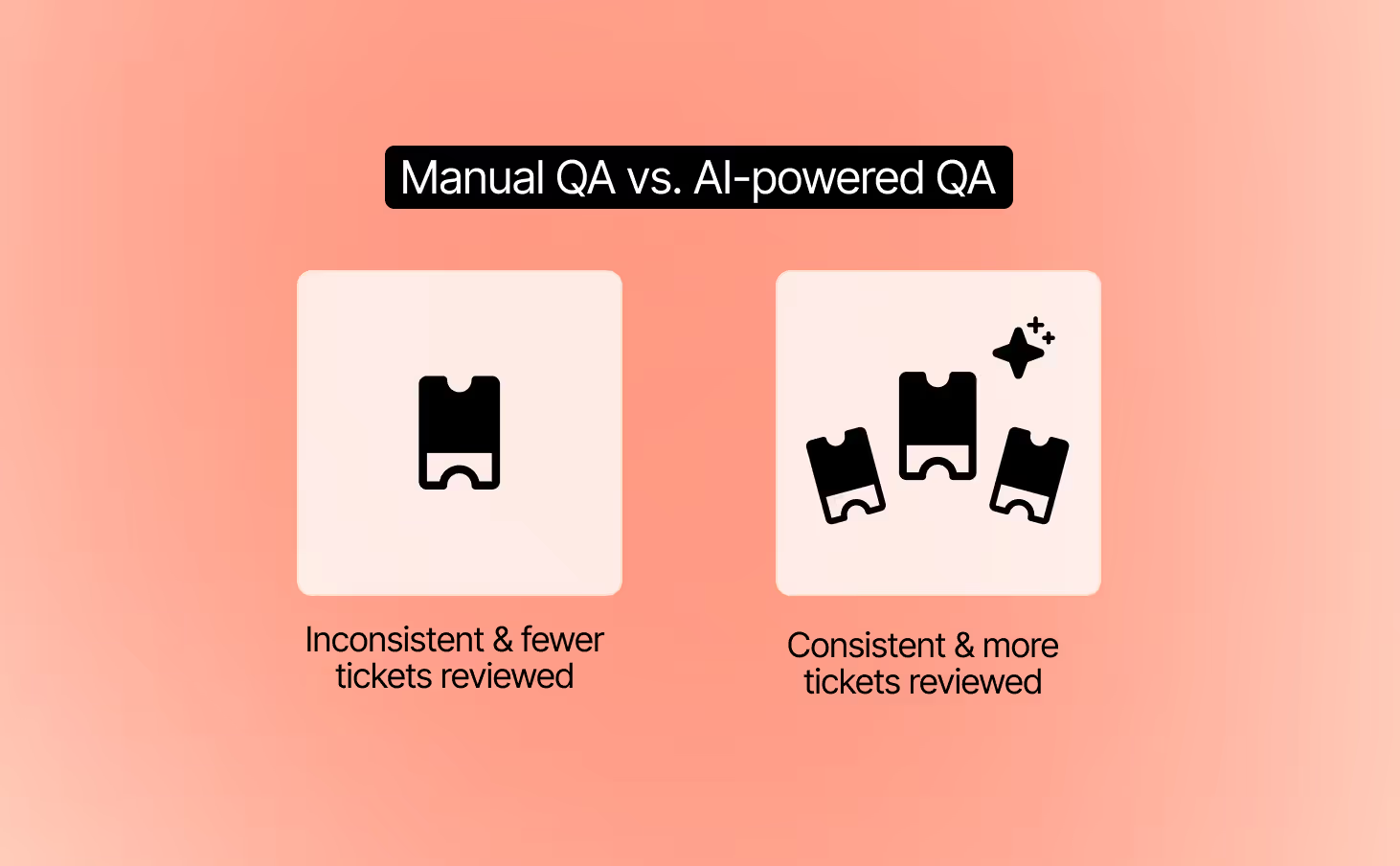
2. Track both agent and AI responses
Customers should get the same level of quality no matter who replies. AI QA evaluates both human and AI conversations using the same criteria. This creates a fair standard and gives you confidence that every interaction meets your brand’s bar for quality.
3. Turn QA insights into coaching opportunities
QA automation is not just about grading tickets. It highlights recurring issues, unclear workflows, or policy confusion. Use these insights to guide targeted coaching sessions and refine AI guidance so both humans and AI deliver better results.
Pro Tip: Pilot your AI QA tool with a small group of agents before peak season. This lets you validate feedback quality and scale with confidence when BFCM volume hits.
Give your ecommerce strategy a boost this holiday shopping season
The name of the game this Black Friday-Cyber Monday isn’t just to get a ton of online sales, it’s to set up your site for a successful holiday shopping season.
If you want to move the meter, focus on setting up strong BFCM automation flows now.
Gorgias is designed with ecommerce merchants in mind. Find out how Gorgias’s time-saving CX platform can help you create BFCM success. Book a demo today.
{{lead-magnet-2}}
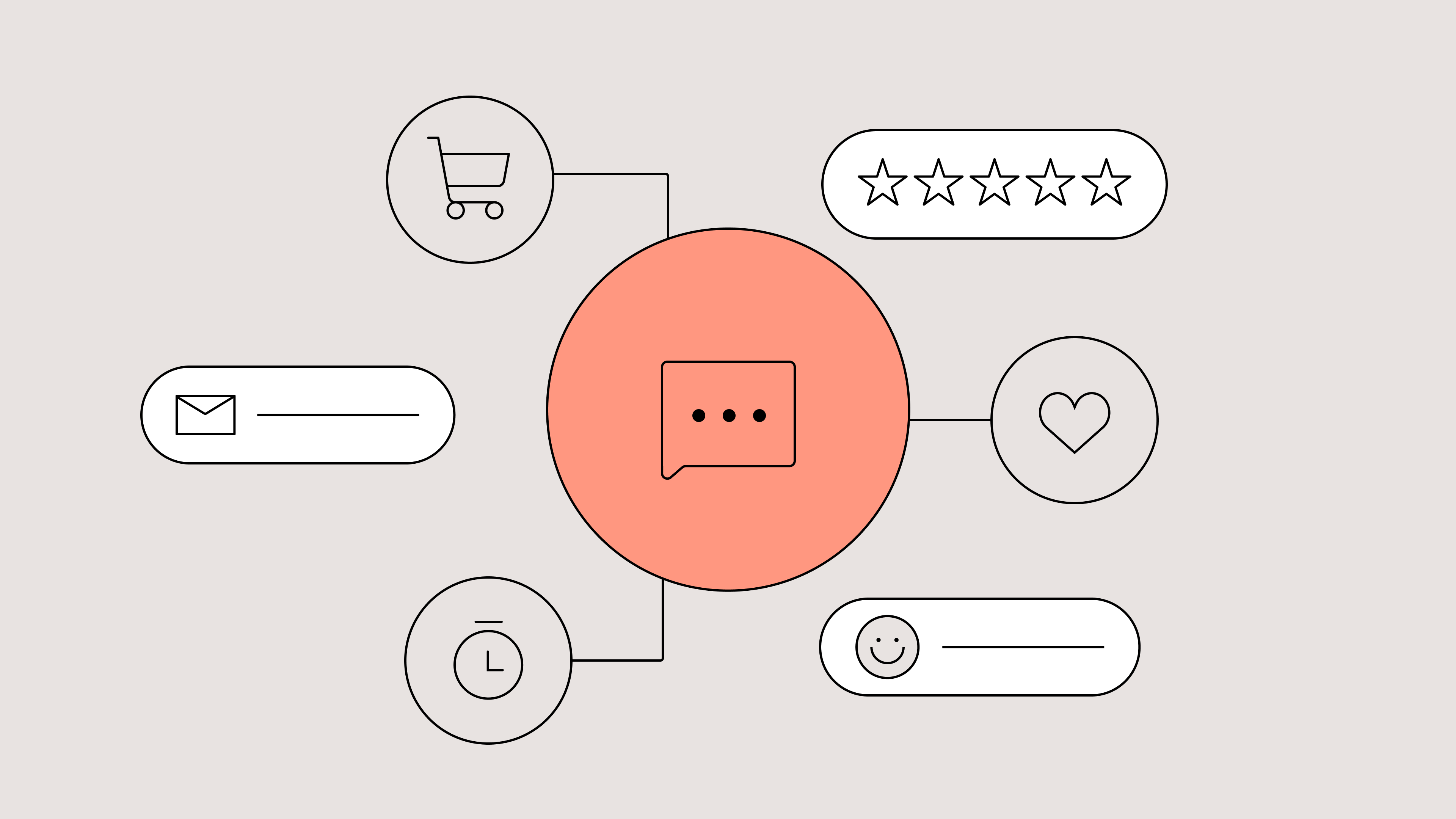
The Power of Suggestion: Why Subtle Cues Create Better Conversations
TL;DR:
- Suggestion turns browsing into buying by gently guiding action instead of forcing it.
- Fewer, clearer choices reduce decision fatigue and help shoppers move forward with confidence.
- A well-timed prompt with a friendly tone can make automation feel like a real conversation.
- Good design earns trust by being subtle, approachable, and easy to engage with.
- Small, thoughtful cues create moments of connection that make shoppers feel understood.
Shopping today isn’t a linear funnel. It’s a fluid conversation. Browse → question → help → buy → return → repeat.
Every step is a dialogue between the shopper’s intent and the brand’s response.
But what bridges the gap between “just looking” and “I’m buying” isn’t persuasion or urgency — it’s suggestion: the subtle design, timing, and language cues that guide action without forcing it.
When done well, suggestion becomes the architecture of trust. It’s also the best way to make AI-powered experiences feel human-first, not tech-first.
This article explores how the power of suggestion — rooted in behavioral psychology and UX design — shapes modern conversational commerce.
{{lead-magnet-1}}
Why suggestion matters in the age of conversational commerce
The average ecommerce shopper faces thousands of micro-decisions from the moment they land on a site. Which product? Which variant? Which review to trust? Which shipping method? Each one adds cognitive weight.
Psychologist Barry Schwartz coined the term The Paradox of Choice to describe how abundance often leads to paralysis. In his research, participants faced with too many options were less likely to make a choice and less satisfied when they did.
In ecommerce, that means overload costs conversions. When shoppers must evaluate too many variables, they hesitate, second-guess, or abandon.
Shoppers today expect empathy and ease, not persuasion. When you suggest rather than push, you signal empathy and support.
This is especially important for conversational commerce. Suggestion humanizes automation by making AI interactions feel like conversations rather than transactions.
When you push and persuade, you create a memorable experience for customers — but it’s not the kind you want them to remember.
One Reddit thread perfectly captures the problem: a user tried to cancel their Thrive Market membership and had to ask nine times before the chatbot complied.
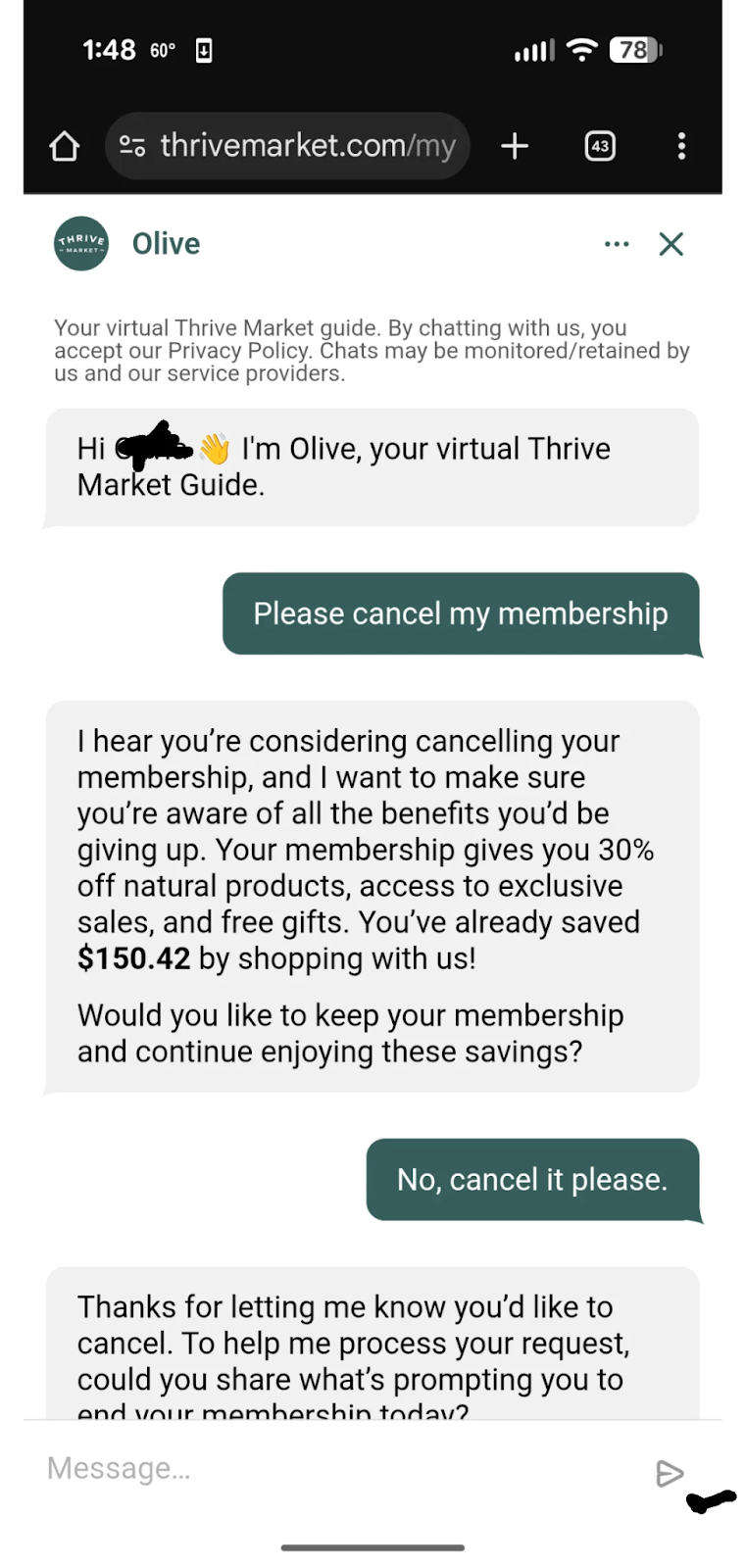
Each time, the AI assistant tried to talk them out of it (offering deals, guilt-tripping responses, or irrelevant messages) until the customer’s frustration boiled over.
The thread exploded not just because it was mildly infuriating, but because it illustrated what customers fear most about automation: a lack of empathy.
Suggestion is how you design for trust, ease, and interaction. And for ecommerce and CX professionals, suggestion bridges browsing and buying by prompting dialogue in a gentle, psychologically sound way.
5 ways to use suggestion with agentic AI
The magic of suggestion is that it works with human psychology, not against it. It bridges the space between what a shopper wants to do and what helps them do it.
That’s the foundation of the Fogg Behavior Model, developed by Stanford’s Dr. BJ Fogg. The model states that behavior happens when three things intersect:
- Motivation — the user wants to do something.
- Ability — they can do it easily.
- Prompt — they’re nudged at the right moment.
When these three align, the likelihood of action skyrockets.
In conversational commerce, suggestion is the gentle push that turns intent into interaction.
Below are five ways to apply suggestion with agentic AI (think chat, assistants, and marketing tools) to drive trust, dialogue, and conversion.
1. Build trust with a friendly invitation
A first impression shapes the entire interaction.
A greeting like “Need help?” or “Looking for something special?” signals availability without applying pressure. It’s the digital equivalent of a store associate smiling and saying, “Let me know if you need anything.”
This works because of linguistic framing, which is a form of persuasive language that subtly shapes how people interpret intent.
- Sentences using personal pronouns (“you,” “we”) increase perceived warmth and empathy.
- Questions (vs. imperatives) activate a conversational schema in the brain, inviting a cooperative response.
- Short, low-stakes phrasing signals that engagement is voluntary.
In practice, this means:
- Replace “Start chat now” with “Need a hand finding the right fit?”
- Use punctuation and tone cues that convey friendliness.
- Let the chat invite linger rather than pop up suddenly — this gives users agency.
Take a look at Glamnetic. Its shopping assistant sits at the bottom-right corner of every page. While shoppers scroll on the homepage, a prompt appears: “Shop with AI.” It’s transparent about being an AI chat, but subtle enough to be there for shoppers when they’re ready to use it at their own leisure.

Gorgias Shopping Assistant is an easy way to do this. At the right moment, Shopping Assistant appears with a greeting such as “Need help?” or “Chat with our AI!” It’s friendly, low-pressure, optional, more “Hey I’m here if you need” than “Buy now!”
2. Make decisions easier by offering fewer choices
If you’ve ever scrolled through 80 product filters and given up, you’ve experienced choice overload. This is the Paradox of Choice in action:
More options = higher cognitive effort = lower satisfaction.
Suggestion works because it reduces mental effort. When an AI assistant limits quick-reply options to just a few (say, “Long sleeve,” “Short sleeve,” “Sleeveless”), it transforms chaos into clarity.
Each small tap provides forward momentum, a concept known as the goal-gradient effect: the closer we feel to completing a goal, the faster and more positively we act.
How can you apply this to agentic AI?
- Keep quick replies between 3–5 choices — enough to feel personalized, not overwhelming.
- Present them as progressive steps, not isolated decisions (e.g., “Show me styles” → “Show me colors” → “Add to cart”).
- Always include a “Something else” or “Other” option to preserve user autonomy.
- Refresh options dynamically based on prior selections — a technique known as choice scaffolding.
Gorgias’s Shopping Assistant does this well, surfacing only the most relevant next steps. Instead of forcing open-ended typing, it guides shoppers through mini-decisions that build confidence. Here’s an example from Okanui, showing four clear options to reply to Shopping Assistant.
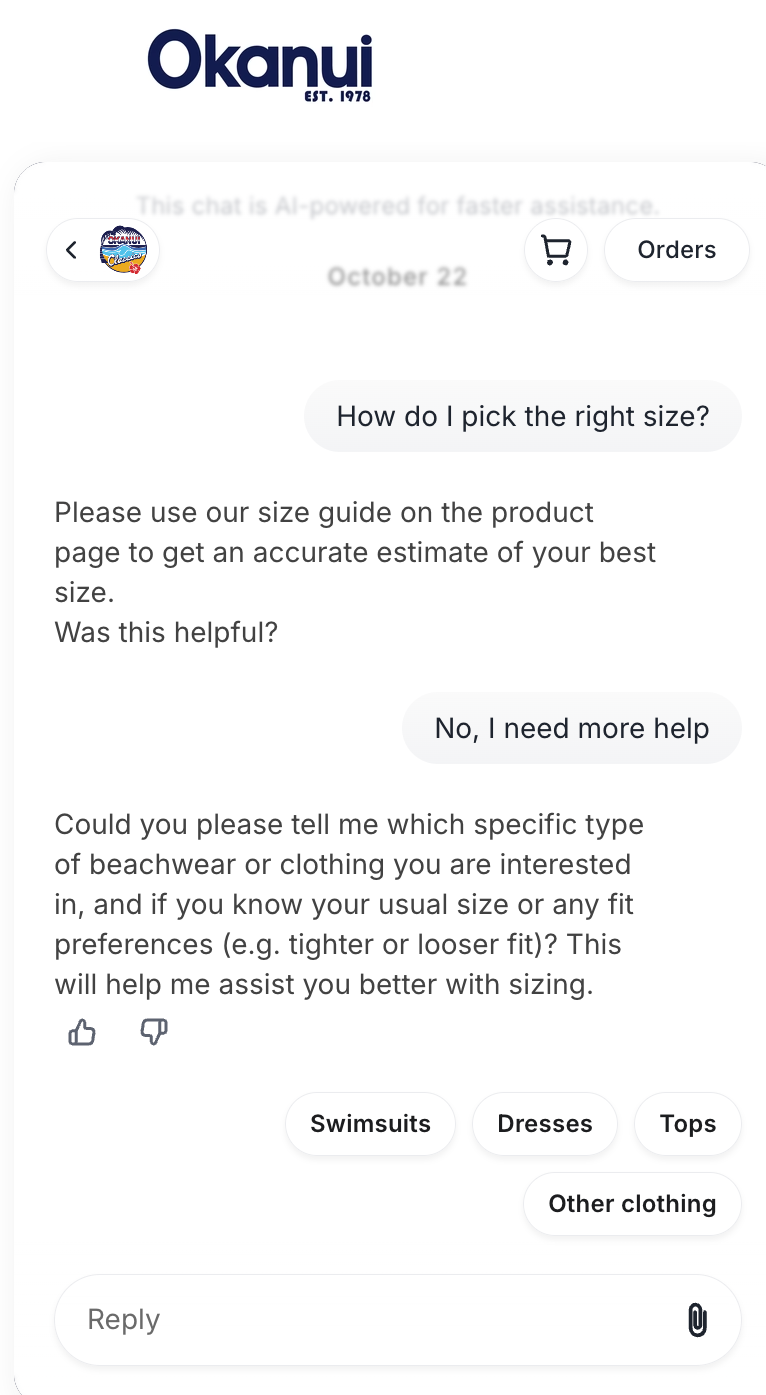
3. Encourage interaction with a user-friendly design
Before a shopper reads a single word of text, their brain has already judged whether your interface feels safe to engage with.
That’s the Aesthetic–Usability Effect — when people perceive something as visually appealing, they assume it will be easier and more trustworthy to use.
Design psychologist Don Norman put it best: “Attractive things work better because they make people feel better.”
Here’s why visual subtlety matters:
- Rounded edges and soft shapes signal continuity and friendliness (the human brain associates curves with safety; sharp angles with danger).
- Muted palettes and neutral contrast lower visual stress, allowing the interface to fade into the background until needed.
- Micro-animations — like a gentle glow or slide-in — trigger attention without hijacking focus.
- Minimizable elements give users a sense of control, reducing resistance to engagement.
OSEA’s product description page is a beautiful example of unintrusive design in action. The buttons have rounded edges, the 10% offer isn’t covering other page elements, and the chat sits in the bottom-right corner, making it easily accessible if a shopper has questions about the product.
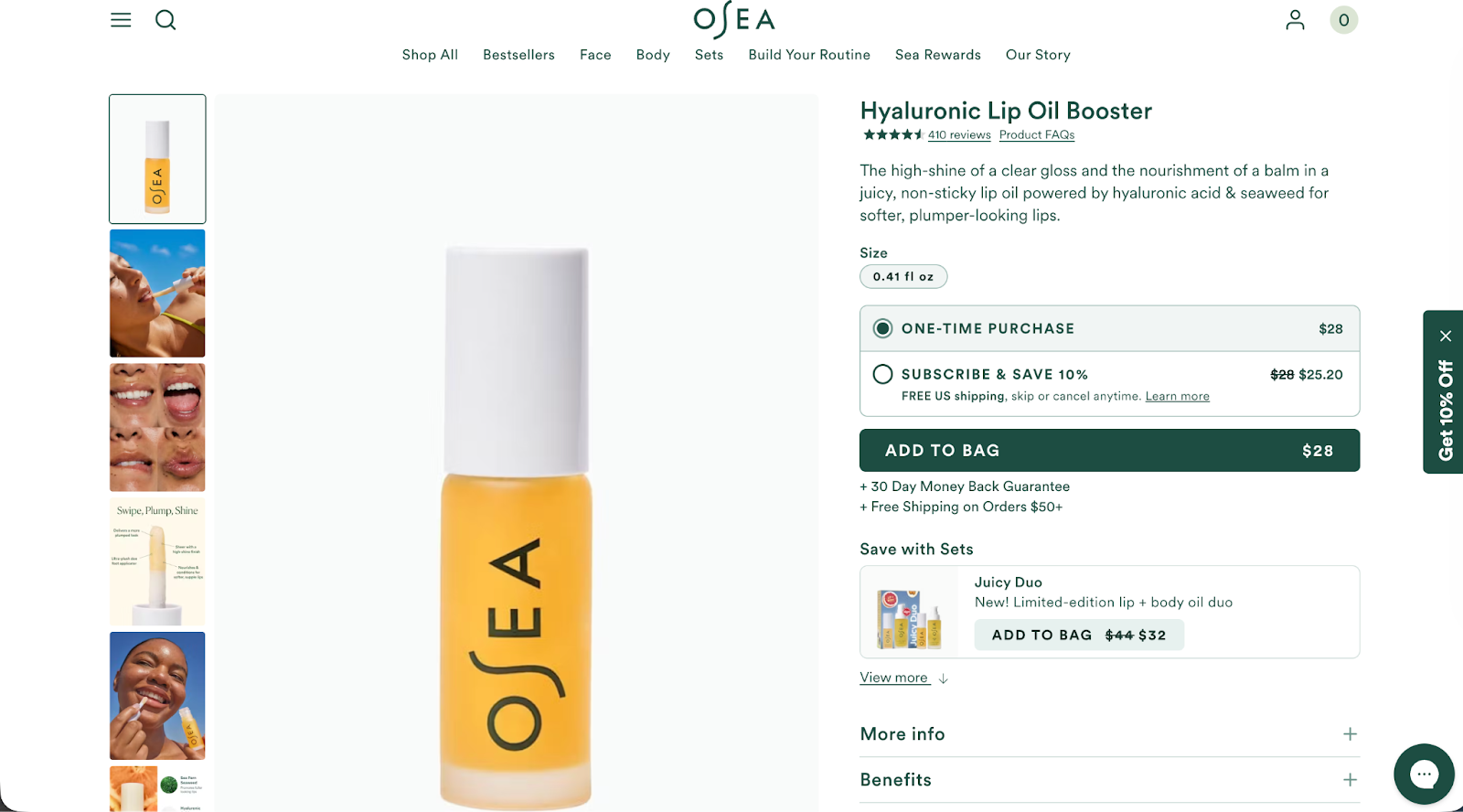
4. Match your timing to the customer’s pace
Timing is everything in suggestion-based design. Even the most thoughtful interaction will fail if it appears at the wrong moment.
That’s where the Fogg Behavior Model becomes tactical: Behavior = Motivation × Ability × Prompt
When shoppers are motivated (interested in a product) and able (engaging is easy), a well-timed prompt (chat bubble, message, or offer) turns potential into action.
But mistime it, and you risk the opposite. A chat that appears too early feels like spam. Too late, and the user’s interest window closes.
Here’s how to align the timing sweet spot:
- Use behavioral triggers: Fire prompts after meaningful engagement (e.g., 25–30 seconds on a product page, reaching 70% scroll depth, or idling for 15 seconds).
- Match prompt to context: Offer size guidance on apparel pages, warranty info near checkout, or live help on return pages.
- Respect frequency: One well-placed nudge beats five redundant ones.
- Localize timing: Adjust based on device and location. Mobile users often need faster cues due to shorter browsing sessions.
Gorgias Shopping Assistant does all of the above. Using context — such as the current page, conversational context, and cart behavior — helps the AI trigger prompts like “Need help choosing a size?” or “Have questions about shipping?”
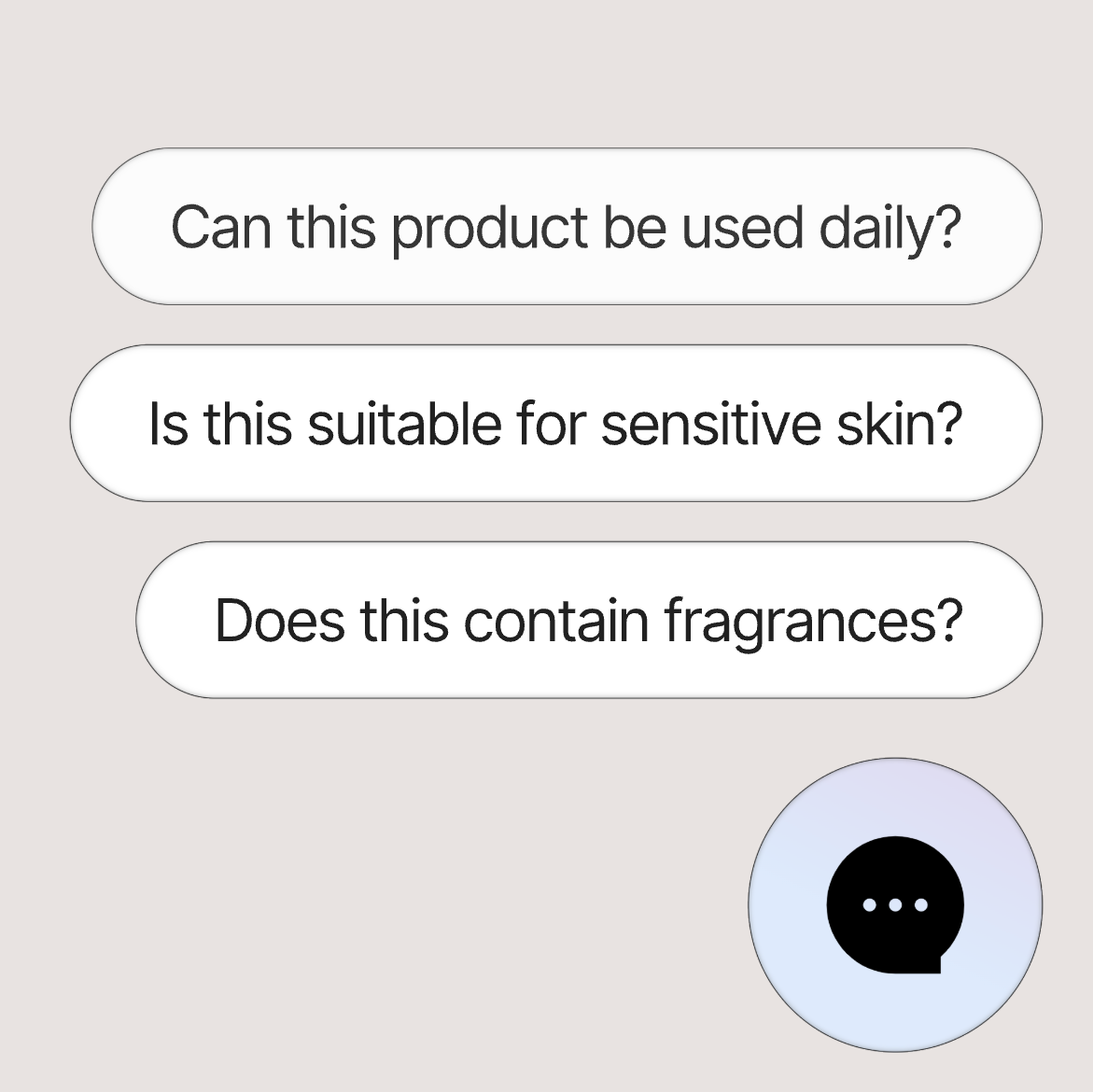
5. Aim to educate, reassure, or inspire — not just sell
Every small suggestion — a phrase, a button shape, a pause, a tone — creates what behavioral economists call a moment of micro-trust.
Individually, these moments may feel insignificant. But together, they turn a static interface into a relationship.
When greeting, choices, design, and timing align, conversation becomes the natural outcome — not the goal. That’s what conversational commerce gets right: it reframes success from “did they convert?” to “did they connect?”
For CX teams, this shift requires designing for the emotional continuity of the experience:
- Did each prompt respect the shopper’s autonomy?
- Did the interaction feel like a two-way exchange?
- Did the system adapt to intent rather than dictate it?
We love this example from Perry Ellis to drive this tip home:

Designing for trust in an age of AI
As AI continues to shape how people shop, brands face a choice: Design for control, or design for trust.
Suggestion is the path to the latter.
The right cue, delivered at the right time, reminds people that even in automated spaces, there’s still room for empathy and understanding.
Gorgias was built on the belief that great commerce starts with conversation, not conversion.
{{lead-magnet-2}}

AI Agent Keeps Getting Smarter (Here’s the Data to Prove It)
TL;DR:
- AI Agent is getting more accurate every month: It’s improved 14.9% this year thanks to better LLMs, constant updates, and user feedback.
- It writes more correctly than most humans: With a 4.77/5 language score, it’s nailing grammar, tone, and clarity better than human agents.
- It’s empathetic, too: AI Agent now shows more empathy and listens better than human agents.
- Brands are gaining confidence fast: Quality scores jumped from 57% to 85% in just a few months, and CX teams are noticing.
- Customers are almost as happy with AI as with humans: AI Agent’s CSAT is just 0.6 points shy of human agents’ average CSAT.
Handing trust over to AI can be intimidating. One off-brand reply and you undo the reputation and customer loyalty you’ve worked so hard to build.
That’s why we’ve made accuracy our top priority with Gorgias AI Agent.
For the past year, the Gorgias team has been hard at work fulfilling the pressing demand for accuracy and speed. AI Agent is getting smarter, faster, and more reliable, and merchants and their customers are happier with the output.
Here’s the data.
{{lead-magnet-1}}
AI Agent delivers more accurate answers than ever
This year, AI Agent’s accuracy rose from 3.55 to 4.08 out of 5, a 14.9% improvement from January. This average score is based on CX agents' ratings of AI Agent responses in the product, on a scale of 1 to 5.
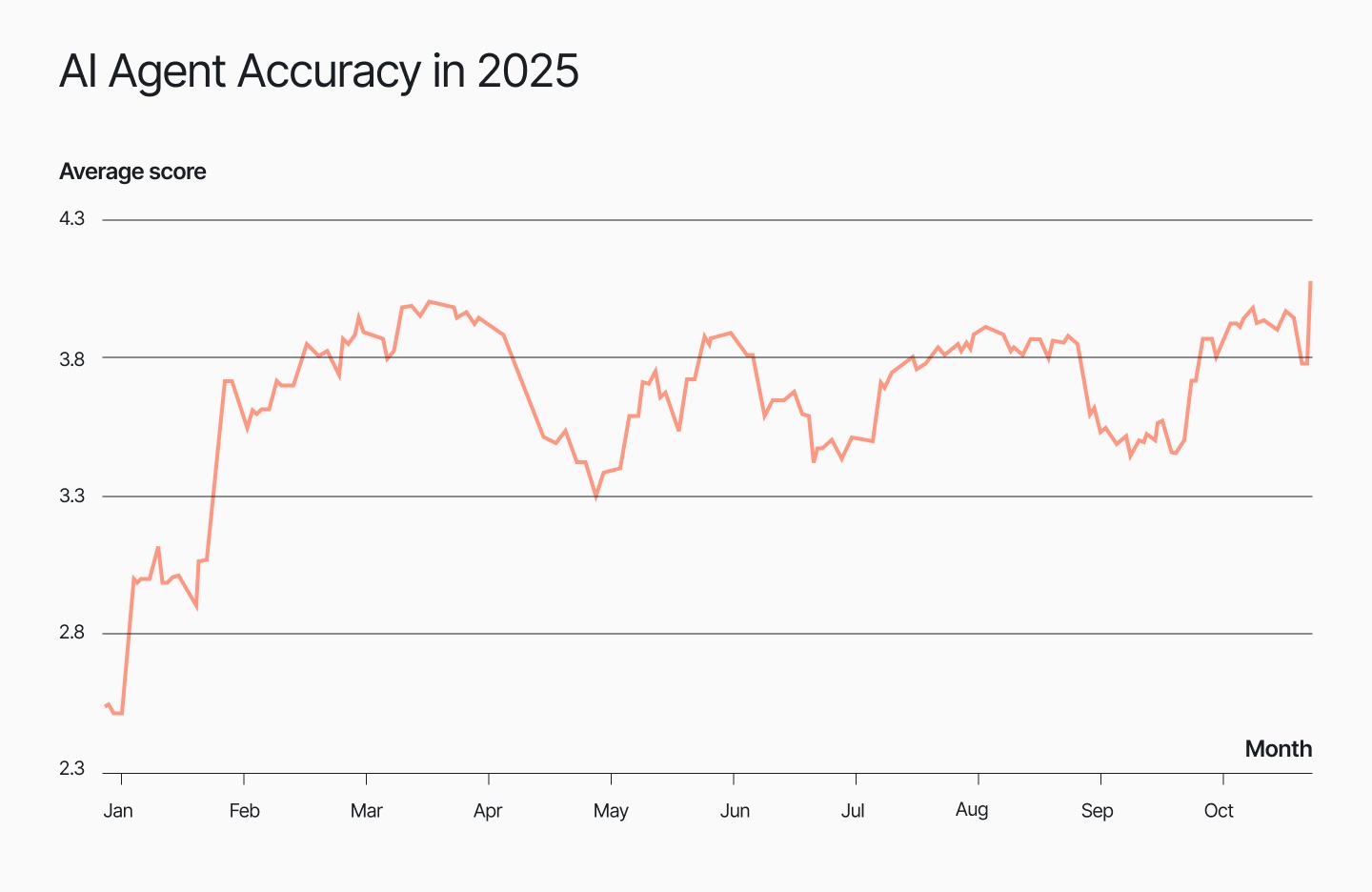
In the past year, we’ve improved knowledge retrieval, added new integrations, expanded reporting features, and asked for more feedback in-product.
We saw the steadiest leap in July, right after the release of GPT-5. AI Agent began reaching levels of consistency and accuracy that agents could trust.
AI Agent writes with more linguistic precision than humans
Clear, easy-to-understand language helps people trust what they’re reading. Website Planet found that 85% more visitors bounced from a page when typos were present. That’s why we’ve made it a priority for AI Agent to respond to customers with correct grammar, syntax, and tone of voice.
The efforts have paid off: AI Agent scores a high 4.77 out of 5 in language proficiency compared to 4.4 for human agents. The result is error-free messages that are easy to read and consistent with your brand vocabulary.
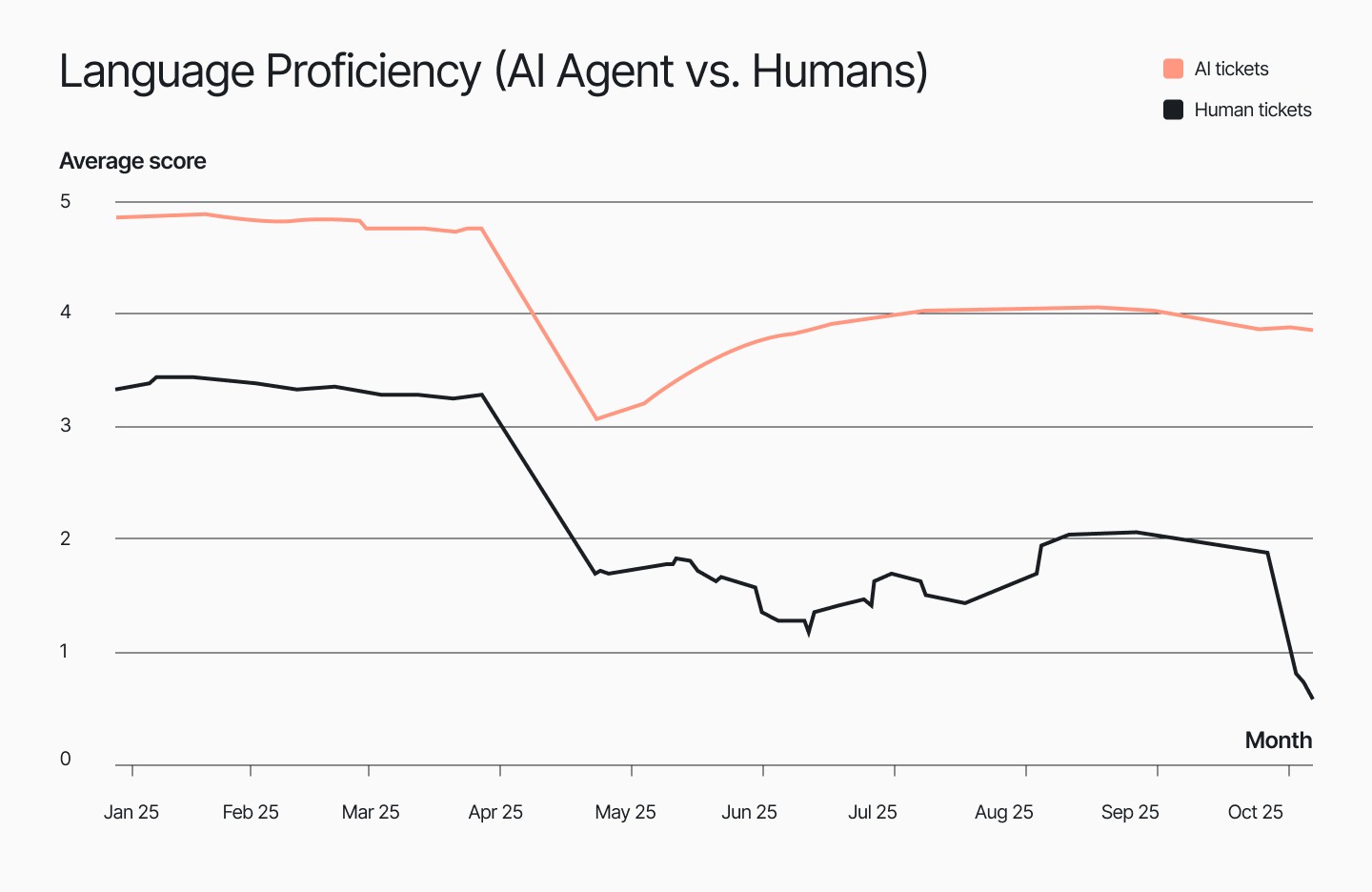
AI Agent shows that empathy can be scaled
Accuracy isn’t just about saying the right thing; it’s also about how a message lands. For that reason, we track AI Agent’s communication quality. Did it reply with empathy? Did it exhibit active listening and respond with clear phrasing?
Recently, AI Agent is even scoring slightly above humans with 4.48 out of 5 in communication, compared to 4.27. This means AI Agent captures the nuance of every message by considering the background context and acknowledging customer frustration before it gives customers a solution.
AI Agent resolves every part of a customer’s question
What happens when a ticket ends without a clear answer? Customers feel neglected and leave the chat still unsure. This can make your brand look out of touch, leaving customers with the lingering feeling that you don’t care.
But don’t worry, we built AI Agent to close that loop every time: AI Agent’s resolution completeness score sits at a perfect 1 out of 1, compared to 0.99 out of 1 for human agents.
In practice, this means customers feel cared for and understood, while your team receives fewer follow-ups, giving them more time to focus on strategic, high-priority tasks.
Read more: A guide to resolution time: How to measure and lower it
Brand confidence is on the rise
Building a great product is a two-way conversation between our engineers and the people who use it. We listen, review feedback, ship changes, and measure what improves.
From January to November 2025, AI Agent quality rose from about 57% to 85%. August was the first big step up, and September kept climbing. Brands are seeing fewer low-quality or incorrect answers and more steady decisions.
This is proof that merchants and their shoppers are witnessing the improvements we’ve been making, for the better.
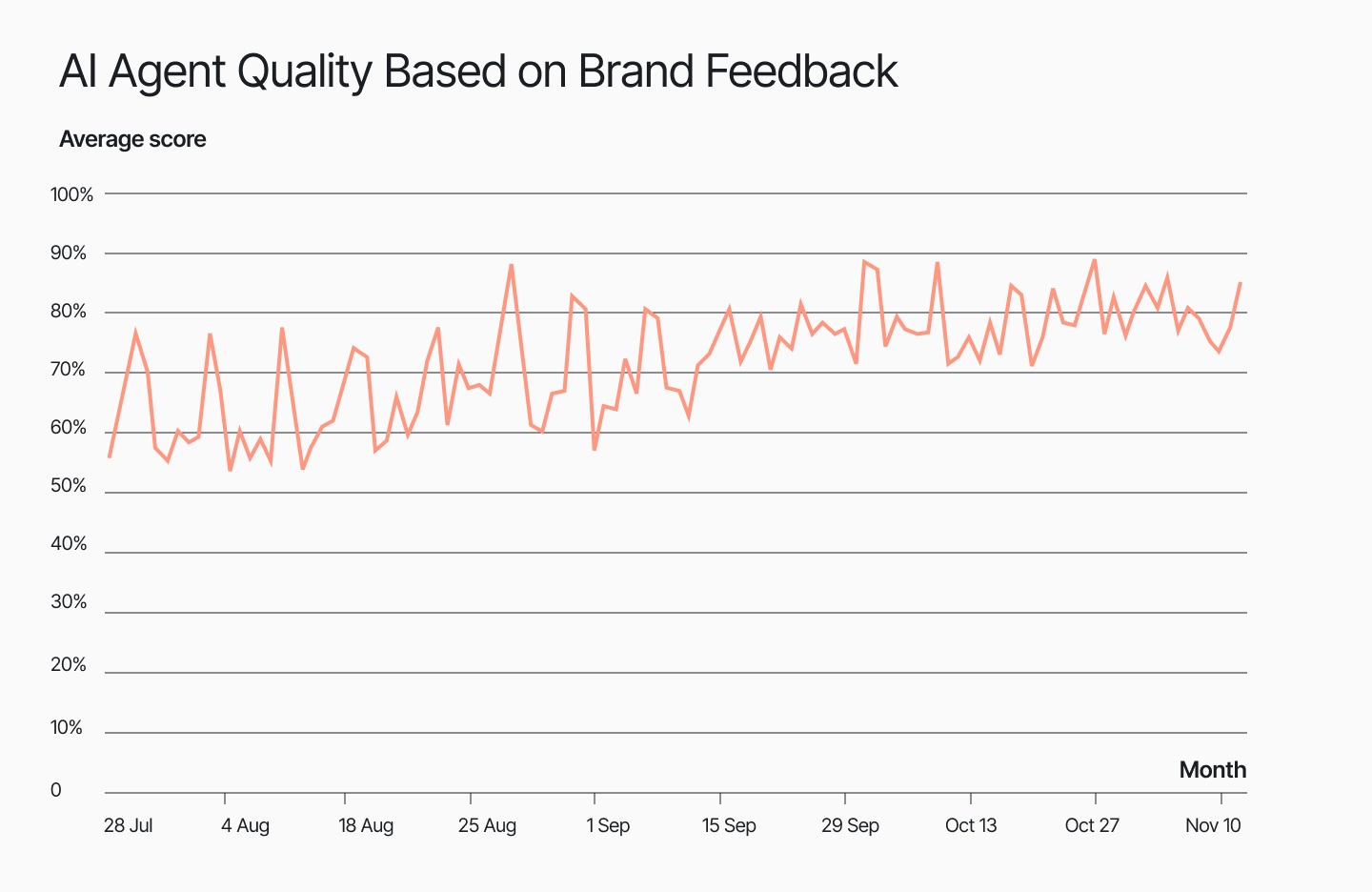
Related: The engineering work that keeps Gorgias running smoothly
Shoppers are rating AI support almost as high as human support
At the end of the day, what matters is how customers feel when they talk to support. Do they trust the answer? Do they find it helpful? Are they running into more friction with AI than without it?
Our data shows that customers are appreciating AI assistance more and more. Since the start of 2025, AI Agent on live chat has gotten a CSAT score 40% closer to the average CSAT of human agents. For email, the gap has narrowed by about 8%.
The goal is to eventually achieve a gap of zero. At this point, AI’s support quality is indistinguishable from that of humans. To get there, we’re focusing on practical improvements like accuracy, clear language, complete answers, and better handoff rules.

How we measure CSAT gap: The CSAT gap is calculated by subtracting AI CSAT from human CSAT. When the number is closer to zero, AI is catching up. When it’s negative, AI is still below human results.
Reliable AI interactions start with accuracy
Behind every accurate AI reply is a team that cares about the details. AI Agent doesn’t make up answers—it follows what you teach it. The more effort your team puts into maintaining an up-to-date Help Center and Guidance, the better the customer experience becomes.
As we look ahead to 2026, we’re focused on fine-tuning knowledge retrieval logic, refining Guidance rules, and continuously learning from feedback from you and your customers.
We’re proud of the strides AI Agent continues to make, and can’t wait for more brands to experience the accuracy for themselves.
Want to see how AI Agent delivers exceptional accuracy without sacrificing speed? Book a demo or start a trial today.
{{lead-magnet-2}}

AI in CX Webinar Recap: Turning AI Implementation into Team Alignment
Further reading

When Should You Migrate Helpdesks? 5 Signs to Watch Out For
TL;DR:
- Your helpdesk shouldn't hold you back. If your team is buried in tickets or bouncing between tools, your platform might be the problem—not your process.
- Rising ticket volumes, slower response times, and clunky integrations are signs you’ve outgrown your platform. Don’t wait for these issues to impact revenue or retention.
- You’re not alone—fast-growing brands hit these roadblocks too. Dr. Bronner’s, Psycho Bunny, and Audien Hearing all switched platforms to support bigger growth with less friction.
- Helpdesk migration doesn’t have to be scary. With the right migration support, you can move quickly, avoid downtime, and give your team a tool they actually want to use.
As ticket volume grows, even the best CX teams start running into roadblocks: limited integrations, repetitive manual work, clunky interfaces, and slower response times. You patch things together. You make it work... until you can’t.
Many growing ecommerce brands find themselves trapped in a system that demands constant workarounds just to function.
If your current customer service platform feels more like a burden than a backbone, you’re not alone—and you’re not stuck.
In this post, we’ll walk through:
- The key signs it’s time to switch platforms
- What to prioritize when choosing your next one
- How brands like Pepper made a smooth move to Gorgias
The 5 warning signs you’ve outgrown your helpdesk
There’s a tipping point most brands hit as they scale. The signs are subtle at first—maybe your agents are taking longer to respond, or the volume of customer support tickets quietly outpaces your team. Then it starts affecting revenue, customer satisfaction, and retention. Big yikes.
Left unchecked, small inefficiencies can snowball into bigger operational challenges.
Catch these warning signs before they start costing you growth:
1. Rising ticket volume and slower resolution times
Support teams that are always playing catch-up rarely have time to focus on higher-value work. If your inbox is constantly overflowing or first response times are creeping up, it’s likely a sign your tools aren’t scaling with your business.
That’s exactly what happened with apparel brand Psycho Bunny.
“As we grew and expanded, we needed a tool that was better suited for Shopify, easier to manage, and offered better support to help us get the most out of the tool,” said Jean-Aymeri de Magistris, VP IT, Data & Analytics, and PMO at Psycho Bunny.
2. Agents constantly toggling between tabs and tools
If your agents are spending more time gathering context than solving problems, you’re losing time (and likely, patience) on both sides of the conversation. Fragmented tools can seriously undercut productivity.
Dr. Bronner’s experienced this firsthand, juggling Salesforce, spreadsheets, and disconnected systems.
“When I joined, we were logging calls and emails in Excel. It wasn’t scalable,” recalled Emily McEnany, Senior CX Manager at Dr. Bronner’s.
3. Clunky or missing integrations with your ecommerce stack
Some platforms require technical support even for small changes, such as custom workflows, new automations, or basic integrations. That may work at the start, but it becomes a bottleneck as your brand grows.
Disconnected systems strip away context, increasing the risk of mistakes. Whether it’s pulling up an order status or managing a return, agents need tools that work together, not against each other.
4. You’re stuck answering the same questions over and over
Every support team deals with repetitive inquiries. But without automation or self-service options, those tickets eat into your team’s time and keep you from focusing on higher-impact conversations.
Nude Project struggled to keep up with their ticket volume due to Zendesk’s lack of intuitive automation features. During Black Friday, the team received a record-high number of tickets—more than double their average volume.
“Connecting with customers through a screen is not always easy. With the high volume of messages, we need a tool that simplifies operational tasks while enabling effective communication and organization,” said Raquel J. Méndez, CX Manager at Nude Project.
5. Onboarding takes too long
Your platform should be easy for new hires to learn and for your team to evolve with. If ramping up agents takes weeks (or months), the platform might be getting in the way more than it’s helping.
Arcade Belts went through this process, trying one system, then switching back to one that better matched their needs.
“It just took a demo or two to realize what was actually going to support our team the way we needed,” their Ecommerce Coordinator, Grant, shared.
If any of these challenges sound familiar, you’re not alone.
The important part is recognizing when you’ve outgrown your current setup—and knowing that there are options out there to help you move faster.
What to look for when switching CX platforms
Switching platforms isn’t just about solving today’s problems. It’s about creating space for your team to be efficient, serve customers better, and turn support from a cost center into a real growth engine.
Need to migrate to a new platform? Look for the following:
1. A system that keeps up with rising ticket volumes
As your brand grows, support volume naturally increases.
Find a stable infrastructure that can handle that growth, has zero platform lag, and a robust engineering team that continuously makes the tool better for your needs.
To Psycho Bunny, Zendesk was a “legacy tool”—so they switched to Gorgias.
In just a few weeks, they migrated all historical conversations, tags, and Macros to Gorgias. Jean-Aymeri, their VP IT, credits Gorgias’s helpful onboarding specialists for making it effortless to integrate their apps and onboard their team onto a brand new tool.
Related: The engineering work that keeps Gorgias running smoothly
2. Automation for repetitive tasks (that maintains the human touch)
From “where’s my order” questions to return policies, prioritize AI tools that can automate repetitive inquiries.
Dr. Bronner’s implemented AI Agent to handle rising volumes of FAQs, allowing their team to focus on complex requests that require a human touch.
In just two months, they saw:
- 45% of all customer service tickets automated
- $100,000 saved per year by switching from Salesforce to Gorgias
- 4 days per month in team time savings
- 11% higher customer satisfaction score
By systematizing the simple stuff, they freed up bandwidth to focus on what matters most—building relationships and solving more nuanced problems.

3. Built-in features that turn support into sales
More brands are rethinking how support contributes to revenue. Look for a tool that combines support and sales. The most effective ones use AI to initiate upselling conversations, so your team can generate new revenue without needing to scale headcount at the same rate.
For jewelry brand Caitlyn Minimalist, which normally saw 30,000 tickets per month, AI Agent was the perfect fit. On top of answering FAQs, AI Agent also helped recommend products based on customer needs.
These conversations often begin as simple inquiries (“What should I get for my friend’s birthday?” or “What product suits me?”) and end in a purchase—handled entirely by AI. In fact, AI Agent’s conversion rates were 150% higher than the team average, proving that automation can support and sell.
4. A more efficient workflow—without relying on developers
The last thing scaling brands should have to worry about is relying on developers for basic changes. That includes being able to create macros and automations in-house and access key customer data without toggling across tools.
The platform should fit into your existing ecommerce stack—not fight against it.
That’s where Audien Hearing found themselves before switching to Gorgias.
“I’ve seen companies lose a lot of money because it’s not efficient,” said Zoe Kahn, former VP of CX. “You try to save money early on, but then you look at your helpdesk a year later and think, ‘Oh no, what’s happening?’”
Since switching from Richpanel, Audien Hearing’s CX team has been able to run CX on their own terms—without the bottlenecks.
They now resolve 9,000 tickets per month through self-service alone (including a customer knowledge base), cut first response times by 88%, and reduced return rates by 5%. With more time for one-on-one conversations, CSAT jumped from 80 to 86.
What migration actually looks like
“But migration sounds hard.”
We get it. Moving your entire CX operation can feel intimidating. But with the right partner (and the right platform), it doesn’t have to be.
Here’s how Gorgias makes switching smooth and stress-free:
- A dedicated onboarding team: Our team is with you every step of the way—from initial setup to post-launch optimization.
- A platform built for ecommerce workflows: Gorgias is designed to work the way ecommerce brands do, not the other way around.
- Fast setup and agent training: Most brands are up and running in days, not weeks. And because the interface is intuitive, teams can get comfortable quickly without heavy, time-consuming training.
- Full data migration support: Whether you’re moving from Gladly, Zendesk, or another platform, we’ll help you bring your history, macros, and workflows over smoothly.
Most Gorgias customers are fully live within just a few days—ready to serve customers faster, smarter, and with less manual lift.
How Pepper made a smooth switch to Gorgias
When fast-growing intimates brand Pepper outgrew their old CX platform, they knew they needed a system that could scale with them—without sacrificing speed or quality.
“Gladly didn’t offer any automation or inbox organization features. Our queue got really messy. We got 400 tickets a day during Black Friday, and we didn’t clear that backlog until the following Spring. We knew we couldn’t do that again,” explained Gabrielle McWhirter, CX Operations Lead at Pepper.
With Gorgias, Pepper was able to:
- Fully migrate their workflows and history
- Train their team quickly on the new platform
- Launch their AI Agent ("Penelope") to automate more than 50% of support tickets

And the results spoke for themselves:
- 16.5x ROI on AI-driven sales interactions
- 90%+ decrease in first response and resolution times
- 18% uplift in average order value
See how Pepper made the switch happen (and why they’re never looking back):
Is it time to make the switch?
If you’re seeing the warning signs, here’s a quick gut check:
- You’re drowning in tickets and toggling between tabs
- You can’t track or tie support to revenue
- You need better integration with your tech stack
- You’re not using automation, or it’s not actually saving time
- Your team dreads logging into your current tool
The right platform won’t just help your team work better. It’ll help you drive more revenue, boost customer retention, and actually make customers want to talk to you.
See what switching to Gorgias could do for your brand. Book a demo today.
{{lead-magnet-1}}

11 Ways CX Teams Can Turn Customer Touchpoints Into Revenue
TL;DR:
- Your CX team drives revenue: Build trust, remove friction, and influence buying decisions across the customer journey
- Optimize existing processes: Automate tasks, address concerns proactively, and create efficient handoffs
- Spot risk early: Use tagging and sentiment detection to re-engage customers before they churn
- Protect VIPs: Prioritize loyal customers, create moments of delight, turn supporters into advocates
Rising tariffs. Shipping delays. Unpredictable price hikes. For ecommerce, it's an understatement to say the pressure is rising. If you're on the CX team, you're already facing the fire head-on — all the customer frustration, confusion, and hesitation.
CX teams are on the frontlines of support and sales. You're shaping customer trust, buying decisions, and brand loyalty.
From pre-sales conversations to loyalty programs, it’s time to rethink the customer journey, so you can turn every interaction into an opportunity to grow your revenue.
{{lead-magnet-1}}
Reframe CX’s role across the customer journey
Customer service isn’t just about reacting to problems. It can be a proactive and strategic function that helps you stabilize and even grow your revenue.
Think about it this way: you have the power to turn everyday customer moments into wins.
At every stage of the customer journey, you can turn:
- Purchase hesitation -> confidence to buy (pre-sales)
- Concern → relief (post-purchase)
- Disinterest -> re-engagement (loyalty)
- Returning customers → brand advocates (advocacy)
This isn’t about being pushy for sales. It's about anticipating needs and putting systems in place that protect customer relationships and revenue.
As you update your CX workflow, keep these two questions in mind:
- How can I positively influence revenue?
- How can I reduce the risk of losing it?
1. Resolve pre-sales hesitation with education
Most pre-sales hesitation is rooted in uncertainty: What’s the return policy? How much is shipping? Will this fit? Will it arrive in time?
Reduce customer effort and build confidence with automation as your CX team’s first line of defense. Anything else more complicated, your agents can take care of.
Automate repetitive questions
Start by setting up automated answers for the questions your team responds to every day, especially the ones that delay conversions:
- Where is my order?
- Do you ship internationally?
- How much is shipping?
- Do you accept returns?
- Are your prices affected by tariffs?
There are a few ways to automate these questions in Gorgias:
- Flows: Automated conversations designed to resolve common inquiries without agent intervention
- AI Agent: Conversational AI that answers customer questions in chat and email, trained on your internal documents and brand voice
- Help Center: A self-serve, customer-facing knowledge base of help articles, FAQs, guides, and product resources
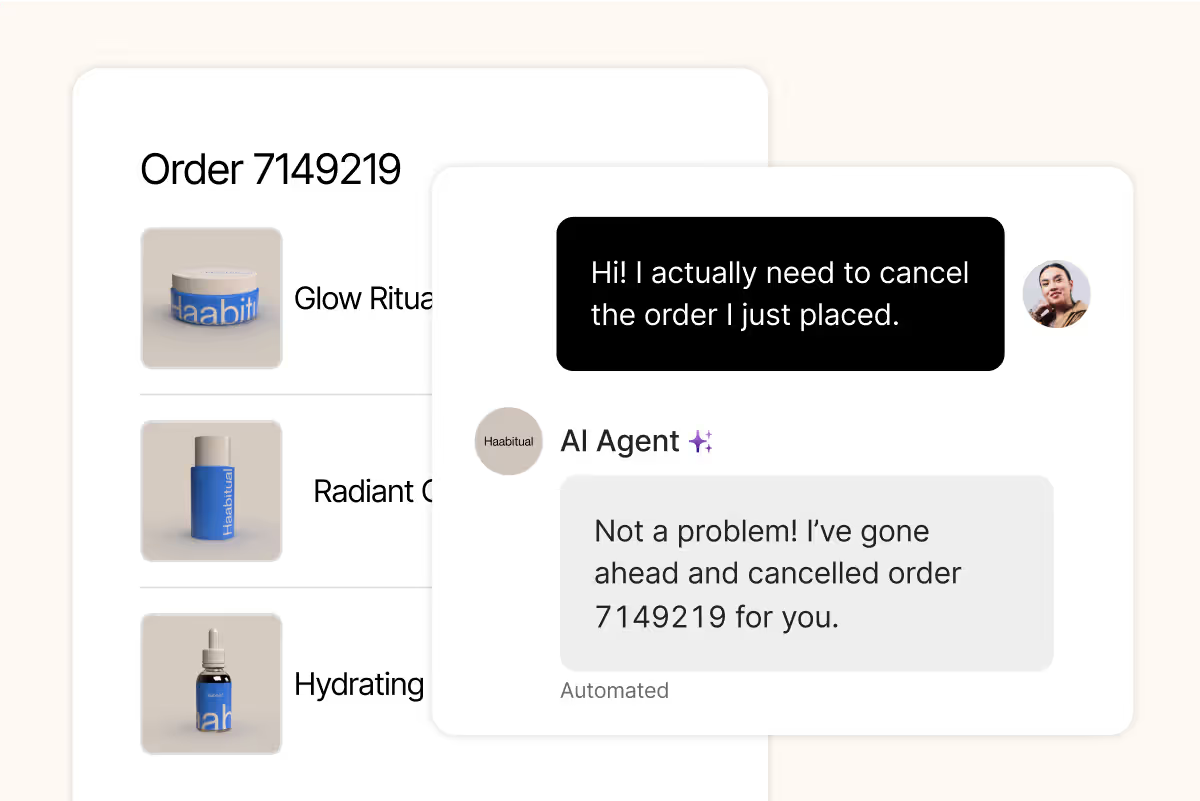
Read more: How to optimize your help center for AI Agent
Proactively guide shoppers
Be the compass for the wandering window shoppers and browsers. They might not know exactly what to get, but with the right nudge, you can guide them toward the right product and a fuller cart.
Try these chat prompts:
- Don’t know what size to get? Check out our sizing guide to get your perfect fit!
- Need help choosing the right carry-on? Here’s a quick comparison of our top sellers.
- We offer free shipping for orders over $60!
- What’s your skin type — dry, oily, or combination?
Offer discounts based on shopper intent
Sometimes, a discount is all a customer needs to take their order to checkout. Instead of storewide promo codes, use AI to offer tailored discounts to shoppers who show strong intent to buy. This can help reduce abandoned carts and leave customers with a great impression of your brand.
Here are some of the best times to offer a discount:
- A first-time shopper is hesitant because of the price
- A shopper adds an item to their cart, then asks about shipping or return policies
- A shopper asks if they should wait for a sale
Recommend products in real time
If shoppers can’t quickly find what they’re looking for, they’ll leave. Real-time product recommendations help resolve indecision and increase average order value.
Examples of when real-time suggestions drive conversions:
- A shopper asks for jeans in medium — AI suggests bestsellers in their size
- A returning customer mentions loving a nude-colored top — AI recommends similar or matching items
- A product is out of stock — AI suggests alternatives based on color or style

Hand off high-intent shoppers to live agents
High-intent questions are usually specific and goal-oriented — things like:
- What size should I get?
- How soon can this ship?
- Is this item still in stock?
When customers ask questions that directly impact their ability to purchase, it’s a strong buying signal. If they don’t get a fast response, they’ll probably abandon their cart.
So, how do you encourage shoppers to keep shopping?
Activate chat on your website and equip it with automated features, such as Flows, and/or conversational AI, like AI Agent.
No matter what setup you choose, always have a protocol ready to hand off to a human agent when needed.
In Gorgias, you can set up Rules or use AI Agent handover rules to automatically route conversations based on specific keywords, topics, or customer behavior.

2. Alleviate post-purchase concerns
After buying, customers may want to change their order or just need reassurance that everything is on its way.
If customers feel ignored during this critical window, you risk losing their business.
The easy fix? Eliminate friction, reassure customers, and make it easy for them to stay excited about their purchase.
Automate order status updates
Customers expect full visibility into their orders. Give them full access to this information, and you'll receive fewer WISMO requests.
Integrate your helpdesk with your 3PL or shipping provider to automatically send real-time updates on order status. If customers have an account portal, give them a tracking link.
Pro Tip: If delays are expected, automate messages to let customers know ahead of time. Being proactive keeps customers informed and reduces the need for reactive support.
Turn negative experiences into retention moments
When something goes wrong, like a delay, a lost package, or unexpected fees, it's how you respond that matters most.
Empower your CX team to act quickly. For example:
- Offer store credit, loyalty points, or free shipping perks to impacted customers
- Prioritize VIP or first-time buyers for fast-tracked resolutions
- Escalate critical post-purchase issues to senior agents
You can also use sentiment detection to flag frustrated customers early. Gorgias has built-in customer sentiment detection that automatically identifies tones like urgent, negative, positive, or even threatening language. You can create Rules that tag these conversations and route them to the right agent for faster handling.
Read more: Customer sentiments
3. Re-engage at-risk customers and reduce churn
Just because a customer is at risk doesn’t mean you’ve lost them. Identifying and re-engaging at-risk customers is one of the highest-impact things you can do to protect revenue.
Spot risk early
Pay attention to repeat patterns that signal dissatisfaction. Common early indicators include:
- Multiple shipping complaints
- Frequent refund or return requests
- Negative or urgent sentiment in support tickets
- Long periods of customer inactivity after purchase
Use sentiment detection and Ticket Fields (ticket properties) to tag these signals automatically. With this data identified, you’ll start to spot patterns that can help you address issues, giving customers a reason to stay.

Build recovery flows
Once you’ve identified your at-risk customers, use win-back strategies, like:
- Offering discount codes, loyalty perks, or free returns
- Sending personalized emails or messages acknowledging the issue and offering solutions
- Prioritizing conversations for your most experienced agents or account managers
When handled thoughtfully, a churn-risk customer can become one of your strongest advocates because you showed up when it mattered most.
4. Build loyalty by surprising your best customers
Don’t forget, there are already customers who love you! These loyal customers don’t just come back to buy again — they bring friends, amplify your brand, and give your business stability when you need it most.
Identify and prioritize VIPs
Use customer data to identify customers who purchase frequently, spend more, or have referred others. Tag them as VIPs in your helpdesk so that their requests are prioritized.
For example, in Gorgias, you can use Customer Fields (customer labels and properties) to group your customers under:
- VIP
- Repeat purchaser
- High lifetime value
- Promoter
When you know who your top customers are, you can offer more personalized service and make sure every interaction strengthens their connection to your brand.
Create brand advocates through small gestures
You don’t need to offer huge discounts to let customers know you appreciate them. Small, thoughtful gestures often make the biggest impact:
- Send handwritten thank-you notes with their orders
- Offer a free gift, upgrade, or loyalty perk after a milestone purchase
- Include a referral code they can share with friends
- Feature loyal customers on your social media channels (with their permission)
If you’re using macros and automations, you can even trigger some of these surprise-and-delight actions automatically, making it easier to scale while keeping the personal touch.
Make revenue your outcome at any time
We know how overwhelming uncertain times can be. It’s easy to think you need to reinvent your entire strategy just to keep up.
But the truth is, you already have what you need. You have a team that knows your customers. You have conversations happening every day that can protect, nurture, and even grow your business.
By grounding yourself in what’s already working and creating proactive systems, you can turn uncertainty into strong and steady growth.
{{lead-magnet-2}}

Store Policies by Industry, Explained: What to Include for Every Vertical
TL;DR:
- Clear policies reduce tickets. When customers can’t find return windows or shipping timelines, they turn to your support team — often unnecessarily.
- Each vertical has different CX needs. A fashion shopper wants fit info. An electronics buyer needs setup help. Tailor your policies to match.
- Proactive placement matters. Don’t bury policies in the footer — surface them in product pages, chat, emails, and account portals where customers actually look.
- Policy + AI = self-service support. Gorgias’s AI Agent can guide shoppers to answers instantly, reducing WISMO and freeing up your team for high-value work.
For many ecommerce teams, store policies are an afterthought, tucked away in the footer or buried deep in the FAQ. But they shouldn’t be.
Great customer experience (CX) starts before a customer reaches out. And with 55% of shoppers preferring self-service support, your store policies are often their first stop for answers.
In this guide, we break down the must-have policies for five key ecommerce verticals, based on real Gorgias ticket data. From shipping delays to subscription changes, you’ll learn how to prevent tickets before they happen.
{{lead-magnet-1}}
Why store policies are a CX power move
If you’re constantly fielding questions about returns, shipping times, or order changes, it’s a policy opportunity.
Well-crafted store policies are one of your CX team's most effective tools for setting expectations, building trust, and preventing support issues before they happen. When done right, they turn common friction points into effortless experiences.
Common blind spots that lead to tickets
When policies are vague or hard to find, customers turn to your inbox, driving up ticket volume and slowing down your support team.
Here are the most common blind spots we see:
- Unclear or missing return windows lead to questions like, “Can I still return this?”
- No defined process for exchanges or edits confuses customers who need to fix an order.
- Subscription rules hidden in fine print frustrate loyal customers trying to pause, skip, or cancel.
- Shipping timelines that shift without explanation cause “Where’s my order?” messages that could’ve been avoided.
When policies aren’t clear or easy to find, customers turn to your inbox. And that means more tickets, wait times, and pressure on your team.
Proactive policies = fewer tickets, happier customers
Based on real data from Gorgias, these are the top 10 tickets customers send across channels like chat, contact forms, and email:
- Order damaged
- No reply tickets
- Shipping policy
- Shipping change
- Order change
- Product question
- Return status
- Thank you tickets
- Discount request
- Shipping status
What do most of these have in common? You can address them with clear, accessible policies.
15 store policies you need, organized by industry
Customer expectations aren’t one-size-fits-all, and your store policies shouldn’t be either.
What shoppers expect from a fashion brand is very different from what they need from a wellness company or electronics provider.
We’ve broken down the top policy must-haves by vertical, using real-world examples from Gorgias customers and ticket data.
Use these examples as your plug-and-play guide to write better policies, reduce ticket volume, and create smoother support experiences — no matter what you sell.
Apparel and fashion
When it comes to fashion, uncertainty drives tickets. “Will this fit?” “Can I return it?” “Where’s my order?” The most successful fashion brands like Princess Polly cut down on support volume by making these answers easy to find before customers ever reach out.
Key policies to prioritize
- Returns and exchanges: Be clear on timeframes, conditions, and the process. Bonus points for adding visuals or quick links to return portals.
- Size guide and fit: To minimize confusion, include details on model sizing, garment measurements, and fit notes.
- Order changes: Let customers know how to update their order before it ships.
- Shipping timelines: Set expectations around processing and delivery windows (especially during peak seasons).


Where to share store policies
- Link return and shipping policies on product detail pages (PDPs).
- Trigger chat campaigns with the sizing guide when shoppers linger on product pages.
- Add return instructions in post-purchase emails to cut “How do I return this?” tickets.
Consumer goods
Consumer goods customers often want to know two things right away: “What’s it made of?” and “When will it get here?” These questions can quickly pile up in your inbox if your policies aren’t front and center.
Trove Brands, home to household favorites like BlenderBottle and Owala, solves this by proactively answering product and shipping questions across their site and emails.
Key policies to prioritize
- Shipping: Share estimated delivery times, carrier information, and instructions on how customers can track their orders.
- Product specs and materials: List dimensions, materials, care instructions, and safety notes to avoid product-related confusion.
- Damage/defect resolution: Set clear expectations around what qualifies as a defect and how customers can report it.
- Warranty or guarantee: Outline what’s covered, for how long, and how to claim it, especially important for durable goods.

At the end of each product page, BlenderBottle shares a support menu where shoppers can find information on order status and replacement parts.

Where to share store policies
- Embed product-related FAQs directly on PDPs to answer questions where they arise.
- Use conversational AI assistants like AI Agent to automatically resolve tickets related to product questions and damaged orders.
- Add warranty and damage policy links in order confirmation and shipping emails to keep customers informed.
Read more: What's the secret to reducing WISMO requests?
Consumer electronics
In electronics, clarity is everything. Customers want to know how to use the product, what to do if it doesn’t work, and how to get a replacement — without jumping through hoops.
Over-the-counter hearing aid company Audien Hearing nails this by creating crystal-clear support content around setup, shipping, and returns, so customers can troubleshoot confidently and independently.
Key policies to prioritize
- Warranty/repairs: Explain what’s covered, how to file a claim, and turnaround times for repairs or replacements.
- Returns and exchanges: Clearly state the return window, list of eligible items, processing time, and whether you accept refunds, in-store credit, or exchanges.
- Shipping and delivery expectations: Share average delivery timelines and what to expect once a product ships.
- Troubleshooting steps: Provide self-service guides for common issues like connectivity, battery life, or setup confusion.
Audien Hearing has clear visual policies that make it simple for shoppers to find the info they need quickly.

Where to share store policies
- In chat, set up an automated flow that answers questions like “How do I set this up?” or “Can I return this?”
- Let customers track their return or exchange process, especially when high-value items are involved.
- Create step-by-step guides, accompanied by video or images, in your Help Center for setup and basic troubleshooting.
- Include warranty and return information in the product packaging, so customers have it readily available in case something goes wrong.
Health and wellness
In the health and wellness space, trust and transparency are everything. Customers want to feel confident that the products they’re using are safe and that the support will be just as thoughtful as the product itself.
Brands like period underwear brand Saalt do this exceptionally well, pairing clear product education with empathetic policies that guide customers through everything from first use to subscription changes.
Key policies to prioritize
- Product safety and use: Provide detailed instructions, safety disclaimers, and FAQs for first-time users, especially for intimate or ingestible products.
- Returns (especially for hygiene items): Be upfront about what can and can’t be returned, and include compassionate language to build trust.
- Order change or cancellation: Make it easy to update or cancel orders, especially for items that ship quickly or automatically.
- Subscription FAQs: Clearly explain how to skip, pause, or cancel a subscription, and what benefits subscribers get.
Saalt lets customers phrase questions themselves or choose from a dropdown menu.


Where to share store policies
- Prioritize clarity on your contact form by using dropdowns or checkboxes to organize customer inquiries by topic.
- Let AI Agent handle recurring product questions like “How do I use this?” or “Is this safe?” to free up your team.
- Include shipping and return info in SMS flows so customers can get answers on-the-go, without needing to email.
Food and beverage
Food and beverage customers tend to be both curious and cautious. They want to know what they’re putting in their bodies — and what to do if something goes wrong with the order.
Brands like Everyday Dose get ahead of these concerns by making their policies clear, accessible, and customer-first.
Key policies to prioritize
- Ingredient and allergen disclaimers: Transparency is everything. List ingredients, possible allergens, and sourcing details to build trust.
- Subscription changes: Give customers full control to pause, skip, or cancel deliveries with minimal friction.
- Damaged orders: Outline what customers should do if a product arrives broken or spoiled, and how fast they can expect a replacement.
- Shipping and delivery FAQs: Cover delivery timeframes, how orders are packed, and what to do if a shipment is delayed.
Everyday Dose lists frequently asked questions and makes it simple for customers to find important allergen and ingredient information.

Given that Everyday Dose is a mushroom supplement brand, many shoppers will likely have questions around allergens and exact ingredients. On each of their product pages, there is a clear “Read the Label” button.


Everyday Dose also has a chat which encourages customers to click through to the correct support link or to track their order.

Where to share store policies
- Enable self-service order management on chat to give customers real-time updates on shipping status and subscription changes.
- Feature policy links prominently in your customer account portal — especially for managing subscriptions.
- Include your damage/return policy in post-purchase and thank-you emails, so customers know exactly what to do if something’s wrong.
Pro Tip: Use a conversational AI platform to handle common questions at scale. For example, Gorgias’s AI Agent can instantly respond to FAQs like “How much is shipping?” or “When will my order arrive?” — all in your brand’s voice. And when a request needs a human touch, it routes the ticket to the right agent automatically.
Best practices for writing and distributing store policies
Even the most well-written policy won’t reduce tickets if it’s buried three clicks deep in your footer. To truly support your customers (and lighten your team’s workload), your policies need to show up in the right places, at the right moments.
Here’s how to get them in front of customers when they need them most:
Surface policies across key customer touchpoints
- Product detail pages: Link to size guides, shipping timelines, or ingredient lists directly on PDPs.
- Chat: Use a combination of automated flows and conversational AI to proactively suggest relevant policies based on the customer’s question or page.
- Help center: Turn your most common ticket topics into easy-to-scan articles with clear titles and headers.
- Email flows: Include return and warranty info in post-purchase emails, shipping updates, and thank-you messages.
- Account portals: Make it easy for customers to manage subscriptions, view order policies, and find FAQs in their account dashboard.
- SMS or mobile support: Include quick policy reminders in transactional texts, like shipping delays or renewal reminders.
3 core elements of a strong store policy
- Clear: Use plain language, short sentences, and bullet points. Avoid legal jargon.
- Accessible: Link them prominently in your footer, header, Help Center homepage, chat, and product pages.
- Actionable: Tell customers exactly what to do — where to click, who to contact, and what to expect.
Well-placed policies turn support into a self-service experience. They empower your customers to get what they need without ever opening a ticket — and that’s a win for everyone.
Turn store policies into your first line of support
Clear, proactive policies do more than answer questions. They prevent tickets, build trust, and make your support team’s job easier. By tailoring your policies to your industry and placing them where customers actually need them, you turn potential friction points into smooth experiences.
Want to take it a step further? Book a demo to see Gorgias’s AI Agent handle common inquiries like shipping, returns, and product questions, across chat, email, and contact forms.
{{lead-magnet-2}}

How CX Leaders are Navigating Tariffs with Transparency
If you're an ecommerce leader right now, you’re likely facing a new wave of uncertainty. Rising tariffs, disrupted imports, and sudden cost increases are putting pressure on your margins, and your customer relationships.
At Gorgias, we are working with thousands of brands that are grappling with tough calls: adjust prices, shift sourcing, or absorb costs to protect loyalty. And while the supply chain is where these issues start, the customer experience is where they play out.
Whether you’re a growing DTC or an enterprise brand, your customers deserve transparency. We know the pressure you're under, and we're here to help you navigate it. To help you not only manage the conversation, but lead it with clarity, empathy, and speed.
Ecommerce brands are in an impossible position right now, following the 24 hours news cycle, and waiting to see how tariffs will cut into profits and impact their business.
For customers? It can create confusion, frustration, and a flurry of angry tickets if brands aren’t proactive and transparent. But here's the truth: how your team talks about tariffs is just as important as what they say.
These moments of friction, and how you communicate these changes to your customers can be opportunities to build trust, reduce churn, and even demonstrate the real revenue power of your team. In a moment when clarity and trust are everything, the role of CX leaders is more important than ever.
When tariffs hit, CX takes the call
Tariffs may seem like a back-end issue, but in reality, they shape front-end experiences—from product pricing and availability to fulfillment speed and satisfaction.
For ecommerce brands, especially those sourcing from China or shipping globally, these trade shifts hit close to home. Products get more expensive, shipping slows down, and some SKUs disappear altogether.
And CX teams are often the first to hear about it. The question isn’t if you should communicate tariff implications, but how.
What customers actually want to know
Here’s the good news: customers don’t expect you to control global trade policy. But they do expect honesty.
What matters most right now is:
- Transparency: Be clear about what’s changing and why.
- Timing: Tell them before they find out at checkout.
- Empathy: Acknowledge that increased prices or delays are frustrating and explain what you're doing to help.
And even more specifically, your customers are likely looking for answers to three simple questions:
- Did the price increase? Why?
- Why can’t I find this product anymore?
- Is my order going to be delayed?
In times of change, trust becomes foundational. If you're not upfront about what’s happening and how it affects them, customers will fill in the blank, or worse, turn to competitors.
How to talk tariffs without losing trust
Be clear, not complicated
Tariffs are complex, but your messaging shouldn’t be. Strip out the policy jargon and explain the changes in human terms. Let customers know what’s changing, why it’s happening, and what steps you’re taking to protect their experience.
Instead of: “Due to regulatory changes impacting import duties…”
Say: “Because of new tariffs, some of our prices have gone up. Here’s why, and what we’re doing to keep costs down.”
Say the same thing everywhere
From your Help Center to your agents to your email updates, your message should be consistent. Mismatched explanations create confusion and erode trust. Align your team on the key talking points and update scripts and automations across all customer touchpoints.
Speaking of your Help Center, now might be a great time to create an article specifically about tariffs and how you’re approaching them. The article can serve as a source of truth for your customers and your AI agents on the front lines answering questions.
Lead with empathy
Customers don’t just want the facts, they want to know you care. Acknowledge the frustration, and offer reassurance. Small gestures like a personalized note or a shipping perk can show you’re on their side.
Be specific and honest
Generic messages fall flat. Give customers details that they can rely on: Are the changes permanent? Are you absorbing part of the cost? Is a specific product impacted? When you’re upfront about the situation, and how you’re responding to it, you build credibility.
Decide how AI Agents should help
Times of uncertainty are times to cut costs, but it may also mean increased ticket volume. AI agents can help on the frontlines. But be sure to build your handovers to escalate to your team in the right moments to build trust.
Start with transparency: Beis sets the bar
Luggage brand, Beis, recently sent an email to customers that is a great example in customer-first communication. Rather than quietly raising prices or burying fees in checkout, they called it what it was: tariffs.

They explained the change clearly, why it was happening, and what customers could expect. And most importantly, they acknowledged the frustration. No spin, or vague language, just a clear message from a brand that respects its customers enough to be honest with them.
This kind of proactive messaging does more than prevent a flood of support tickets. It creates alignment between the brand and the customer. Beis didn’t make the rules but they’re navigating them with their customers, not in spite of them.
Make it a CX conversation, not just a policy page
Too often, tariff policies get relegated to the FAQ page or terms and conditions. Customers typically only land there after they’re already confused or upset.
Instead, CX should treat tariffs as a key part of the customer journey and be equipped to speak about them empathetically and clearly.
1. Proactive chat leads to fewer surprises
Add a proactive message to your chat widget that addresses tariff-related questions before they even come up. A short note like, “You may notice some pricing changes – here’s why,” with a link to your FAQ or a specific article, helps to deflect confusion and prevents cart abandonment.
2. Update your FAQ with key information
Surface timely information right where customers are most likely to look. Use your chat or search function to include a clear callout.
“Looking for information on recent pricing or shipping updates? Here’s what changed.”
This type of visibility empowers self-service, and reduces ticket volume.
3. Equip your agents with scripts that are genuine
Don’t leave your support team guessing. Create internal scripts with clear language on what to say (and what to avoid) when talking tariffs. Script empathy, not just compliance: Empower agents with language that acknowledges the inconvenience while reinforcing the brand's values.
Say:
- We’ve made some pricing updates due to new tariffs, and we’re doing everything we can to minimize the impact.
- We know this change may be frustrating. Here’s how we’re helping our customers through it.
Avoid:
- Overly technical or vague terms like “regulatory adjustments” or “economic climate shifts.”
- Any messaging that deflects responsibility or blames external factors without explanation.
4. Build smart macros for Tariff FAQs
If you’re using automation, make sure your AI Agent and autoresponders can explain tariff policies accurately and compassionately. Use macros to ensure fast, consistent replies, without sacrificing tone. Some key macro themes to create:
- Why did prices increase?
- Are tariffs permanent?
- Is my order delayed because of tariffs?
- Why is this product no longer available?
Each macro should strike a balance of clarity, empathy, and brand voice, offering both the what and the why.
You can’t control tariffs. But you can control trust.
Tariffs might be out of your control. But how you talk about them? That’s entirely in your hands.
This is your moment as a CX leader, not just to react but to lead. To turn friction into transparency, tension into trust, and confusion into connection. Because when policies change overnight and customer confidence is on the line, the brands that communicate with honesty, consistency, and care don’t just survive. They strengthen loyalty.
Your customers don’t expect perfection. They expect clarity. They expect empathy. And they expect you to show up.
At Gorgias, we’re here to make sure you can. With tools to automate answers, personalize conversations, and empower your team to deliver the kind of CX that builds long-term brand equity, even when times get tough.

Stop Chargebacks Before They Start: The Power of Fast Customer Support
TL;DR:
- Most chargebacks occur due to poor merchant communication rather than fraud. Customers choose this path when they feel ignored or frustrated.
- 80% of customers report never being contacted by merchants after filing a chargeback. 23% file immediately after an issue and 38% file within 1-3 days if unresolved.
- The most common chargeback reason is "product not received" (35%). 79% of all chargebacks are actually "friendly fraud" filed for invalid claims.
- Prevention requires fast customer support and automated chargeback management. Combining Gorgias for AI-powered support with Chargeflow for automated dispute management provides a comprehensive solution with faster resolutions and higher win rates.
Chargebacks are more than a thorn in a merchant’s side — they’re a growing financial and operational threat. According to Ethoca, chargebacks are projected to more than double, from $7.2 billion in 2019 to $15.3 billion by 2026 in the U.S. alone. And while fraud plays a role, the primary reason customers file chargebacks is simpler: they feel ignored.

At Chargeflow, we recently published a comprehensive report analyzing why customers dispute chargebacks. The findings were eye-opening. While it’s true that fraud is a real concern, most chargebacks happen for a different reason: a lack of communication between merchants and customers.
Top stats from Chargeflow’s report:
- 23% of customers file a chargeback immediately after an issue.
- 38% file a chargeback within 1-3 days if unresolved.
- 80% report never being contacted by the merchant.
- 52% are likely to dispute if the response is too slow.
When customers feel ignored or frustrated, they often turn to their bank for a solution instead of reaching out to the merchant first. Understanding these behaviors is key to preventing disputes before they escalate and cause chaos.
So, what actually drives customers to dispute charges? Here’s what the data says.
Why customers file chargebacks
While chargebacks are often the cost of doing business, the truth is that many disputes are preventable — but only if merchants understand the root causes. We identified five key drivers behind chargebacks.
1. Customers take immediate action
According to our research, most customers file a dispute right away after encountering an issue, leaving no opportunity to resolve the problem. Another 38% file within one to three days if they don’t receive a timely response.
Why? Customers assume the fastest way to get their money back is by filing a chargeback, especially if they receive no response from the merchant.
2. Lack of communication leads to disputes
We found that 80% of customers never receive a follow-up after filing a chargeback. Additionally, 64% of customers state immediate communication is crucial, yet many businesses fail to reach out.
- 90% of customers tried to reach out to the merchant first.
- If they don’t receive a response, they quickly file a dispute.
Why? Customers expect businesses to be proactive. When they don’t hear back quickly, they assume the merchant won’t help, making a chargeback seem like the best option.
3. Chargebacks are too easy for customers
98% of customers report a neutral to highly satisfactory experience when filing chargebacks, and only 12% are denied.

Why? Many customers believe chargebacks are faster and easier than dealing with merchants directly, especially if return policies are unclear.
4. Transaction issues drive chargebacks
The most common reason for filing a chargeback is “product not received” (35% of the cases). Other common reasons included:
- Fraudulent transaction claims - 16%
- Product significantly not as described - 15%
- Unauthorized transaction - 15%
Why? When customers don’t receive clear shipping updates or experience delivery delays, they assume their order won’t arrive and file a chargeback rather than waiting.
5. Friendly fraud is a major problem
Friendly fraud occurs when a cardholder makes a legitimate purchase but later disputes the charge as fraudulent or unauthorized, leading their card issuer to reverse the payment.
Our research found that:
- 21% of customers admitted to not fully understanding the chargeback process.
- Another 20% aren’t even aware of what a chargeback is.
- 97% of consumers believe they’ve never filed a chargeback incorrectly, while only 3% admit they have.

According to our State of Chargebacks report, 79% of chargebacks are actually friendly fraud, meaning they were filed for invalid reasons.
Why? Many customers mistakenly believe that a chargeback is just another way to request a refund, rather than a process intended for fraud or merchant failure.
📌 The takeaway: Most chargebacks aren’t actual fraud, but rather a result of customer confusion, impatience, or poor communication from merchants.
The solution: how to stop chargebacks before they happen
Merchants who want to stop chargebacks before they happen need a two-part strategy:
- Fast, customer-focused support to resolve issues before customers dispute charges.
- Automated chargeback management to detect and fight disputes efficiently, so merchants don’t lose revenue to invalid claims.
Chargebacks result from slow response times, poor communication, and unresolved issues, not fraud. Adopting AI-driven customer support and chargeback automation allows businesses to significantly reduce disputes and retain more revenue.
How AI-powered support & chargeback automation work together
Instant responses prevent frustration-driven chargebacks
Many chargebacks happen because customers don’t receive a fast enough response. In fact, 52% say they will dispute a charge if the response time is too slow. AI-powered chatbots provide real-time support, resolving issues before they escalate.
Proactive communication reduces uncertainty
Customers expect updates regarding orders and refunds, but often don’t receive them. 80% of customers report never hearing from a merchant after filing a chargeback.
Automated order updates, refund confirmations, and proactive notifications keep customers informed, reducing unnecessary disputes.
24/7 availability ensures no issues go unanswered
Customers expect round-the-clock support, but most businesses can’t provide live assistance. AI-powered ticketing and automation ensure every customer receives help, regardless of the time zone or urgency.
The result? Fewer chargebacks, faster resolutions, and increased customer satisfaction.
Actionable strategies for improving response times
Prioritize long-term clients
It’s impossible to please every customer. On average, chargebacks take 50 days to resolve successfully. Focus your energy on retaining high-value, long-term customers.
Prioritize high-risk inquiries
Lost inquiries take on average 15 days to resolve, and lost chargebacks take 38 days. Prioritize cases based on impact.
Build efficient escalation systems
Advanced automated ticketing systems can route inquiries and prioritize urgent cases.
Use pre-approved resolution templates
Ensure customer service teams have quick-response templates to speed their resolutions.
Work closely with shipping carriers
“Product not received” was the most cited reason for delivery-related chargebacks. Work closely with carriers and third-party suppliers to improve fulfillment and reduce disputes.
Leverage chargeback management tools
Use automated tools for real-time analytics, enhanced communication, and proactive alerts, which will reduce response times.
Gorgias & Chargeflow: A fully automated chargeback prevention system
Successfully tackling chargebacks requires both proactive customer support and automated dispute management. That’s why Gorgias and Chargeflow work so well together to give merchants a comprehensive defense against disputes.
Post-purchase automation isn’t just about reducing customer support workload or quick replies. It's about finding the most effective ways to increase customer loyalty and prevent disputes.
Learn more about how AI-driven automation enhances post-purchase experiences here.
How Gorgias prevents chargebacks with conversational AI
- Automated real-time responses engage customers before they decide to dispute charges.
- Proactive customer communication ensures customers receive updates on their orders, refunds, and transactions.
- 24/7 availability ensures customers receive the support they need without increasing overhead.
How Chargeflow automates chargeback prevention & recovery
- Pre-dispute alerts notify merchants before a chargeback is finalized and provide proactive intervention.
- AI-powered chargeback responses to automate evidence collection and improve win rates.
- Smart analytics to help merchants understand why disputes happen and how they can prevent them.
Final thoughts: Stop chargebacks before they start
As you know, chargebacks are costly, frustrating, but most importantly, preventable. Our research shows that most chargebacks don’t stem from fraud, but from poor communication, slow response times, and customer uncertainty.
By prioritizing fast, AI-driven customer support and automated chargeback management, merchants can resolve issues before they escalate, improve customer experience, and protect their revenue.
With Gorgias handling proactive customer support and Chargeflow managing chargeback disputes, merchants get a powerful, end-to-end prevention system that ensures fewer chargebacks, higher dispute win rates, and, at the end of the day, happier customers.
Don’t let chargebacks drain your revenue. Take control today with faster, smarter automation.
Download Chargeflow’s full Psychology of Chargebacks Report to dive deeper into the data and start preventing disputes before they happen.

The Engineering Work That Keeps Gorgias Running Smoothly
TL;DR:
- Gorgias eliminated helpdesk outages by implementing multiple database connection pools with PgBouncer, achieving over 99.99% uptime.
- We accelerated data retrieval by organizing 40TB of data into 128 partitions, reducing query times to less than 4ms.
- Our streamlined incident response process with dedicated Slack channels and clear roles now resolves almost all incidents in under an hour.
- Looking ahead, we're strengthening security, doubling our SRE team, implementing production readiness reviews, and enhancing monitoring tools.
When customer service teams are at their busiest, they need a helpdesk that keeps up. That’s exactly why our Site Reliability Engineering (SRE) team has been working behind the scenes to make the Gorgias platform faster than ever.
Over the past year, we've made remarkable improvements to our platform to eliminate bottlenecks, speed up data retrieval, and reduce incidents. For you, this means fewer disruptions, faster load times, and a more reliable helpdesk experience.
Here's how we did it.
Eliminating helpdesk outages by increasing our connection pools
The challenge
Our platform relied on a single, shared database connection pool to manage all queries. Think of it as having just one pipe handling all the water flowing through your house — when too much water rushes in at once, the whole system backs up.
In practice, this meant a single surge in database requests could clog the entire system. When lower-priority background tasks got stuck, they could prevent high-priority operations (like loading tickets or running automations) from working properly. This would cause the entire helpdesk to slow down or, worse, become completely unresponsive.
The solution
Using PgBouncer, a tool that manages database connections and reduces the load on a server, we implemented multiple connection pools. Instead of relying on a single pipeline to stream all requests, we created separate "pipes" for different requests.

Like how road traffic picks up again after an exit, routing our database traffic into separate connection pools makes sure high-priority customer interactions don’t lag behind automated background tasks.
This solution is future-proof. In the event that a lower-priority task is delayed in one connection pool, other functionalities of the helpdesk will continue working because of the remaining connection pools.
The benefits
The results speak for themselves:
- Complete elimination of helpdesk-wide outages caused by connection pooling issues
- Faster response times — 99% of automated rules tasks take less than 800 milliseconds to complete from inception
- Partial degradation instead of full outages if issues do occur — at worst, only a single feature might be affected instead of your entire helpdesk
We've eliminated incidents caused by connection pool issues in the helpdesk completely. This reduced major helpdesk outage incidents by around four per year and maintained an average uptime of over 99.99%.
Speeding up the helpdesk by organizing 40TB of data into 128 partitions
The challenge
As Gorgias grew to over 15,000 customers, so did the volume of data. We’re talking data from tickets, integrations, automations, and many more. The combination of more users and data meant slower searches within the helpdesk.
However, the amount of data was not the problem — it was how our data was organized.
Imagine this: An enormous storage room full of file cabinets containing every piece of data. Sure, those file cabinets kept data organized, but you would still need to spend time searching through the entire room, running up and down aisles of cabinets, to find your desired file. This method was cumbersome.
We needed a more efficient way to keep our data easy to find, especially as more customers used our platform.
The solution
The answer was database partitioning — breaking our large datasets into smaller, more manageable segments. Using Debezium, Kafka, and Kafka-connect JDBC, all managed by Terraform, we migrated over 40TB of data, including 3.5 billion tickets, without a moment of downtime for our merchants.
Instead of a giant room with thousands of file cabinets, we divided that giant room into 128 smaller rooms. So now, instead of looking for a file in one room, you know you just need to go into room number 102, which has a much smaller area to search.
This approach allows our system to quickly pinpoint the location of data, significantly reducing the time it takes to find and deliver information to users.
Additionally, database maintenance has become more efficient. Some of the partitions can probably sit without needing to be changed at all. We just have to maintain the partitions that are getting new files, which cuts down on maintenance time.
The benefits
Better database partitioning provides several benefits:
- Faster queries — We have an average of 600 lookups or updates per second across these databases, each taking less than 4ms
- More efficient database maintenance — We halved the number of automated maintenance runs and cut each run’s duration in half
- Better scalability as our infrastructure is now equipped to handle continued customer growth
Faster resolutions with a streamlined incident response process
The challenge
When incidents occurred in the past, our response process was inconsistent, leading to delays in resolution. It was sometimes unclear who should take the lead, what immediate actions were required, and how to effectively communicate with affected customers.
Additionally, post-incident reviews varied in quality, making it difficult to prevent similar issues from happening again. We needed a standardized framework to address incidents in a timely fashion.
The solution
To streamline incident management, we introduced a replicable, automated process:
- Dedicated Slack channels — Every incident gets its own Slack channel, ensuring our team is immediately notified.
- Clear roles & responsibilities — We defined specific roles so every engineer knows what next steps to take.
- Retrospectives — After each incident, we conduct thorough post-mortems to analyze root causes, identify improvements, and share learnings across teams.
- Proactive prevention — By improving our monitoring tools, we catch potential issues earlier, reducing the likelihood of major disruptions.
The benefits
With our improved incident management process:
- Response times have decreased significantly — almost all incidents are mitigated in under an hour
- Customers receive clearer communication during incidents, including our regularly updated Gorgias Status page
- 100+ smarter preventative measures to reduce the overall incident frequency or permanently fix recurring problems
What's next: Four ways we're improving the platform experience
With more brands catching on to how essential a solid CX platform is, our team's got our work cut out for us. Here's what's on the way:
- Enhanced security measures — We've hired a dedicated security engineer to strengthen our security infrastructure.
- A bigger SRE team — Our Site Reliability Engineering team has doubled, allowing us to address performance issues rapidly.
- Production readiness reviews — We're formalizing a process to audit new and existing services, ensuring they meet our reliability standards before deployment.
- Improved monitoring — We're investing in better monitoring tools to detect and resolve potential issues before they impact customers.
Count on a reliable future with Gorgias
Gorgias will inevitably face new challenges in performance — no system is completely immune to downtime.
But we've built our architecture with the future in mind, and it’s more resilient than ever as more and more brands realize the power of conversational AI CX platforms.
The result? A platform you can count on to help you deliver exceptional customer service, without technical issues getting in the way.
{{lead-magnet-1}}

9 Ways to Use AI to Personalize the Customer Journey
TL;DR:
- Use AI across both support and sales. Ecommerce brands are using AI to drive revenue and efficiency by combining automation in chat, email, and customer data with personalized product guidance and upsells.
- Analyze post-purchase surveys with AI to uncover customer insights. AI quickly identifies themes, sentiment, and trends from open-ended feedback to inform product, shipping, and support decisions.
- Predict customer intent with AI before they take action. By analyzing behavior like cart activity or page views, AI can engage high-intent shoppers with personalized nudges in real time.
- Automate QA and proactive support with AI. AI reviews 100% of conversations, flags quality issues, and triggers outreach for known problems — all before customers even ask.
Shoppers aren’t just open to AI — they’re starting to expect it.
According to IBM, 3 in 5 consumers want to use AI as they shop. And a McKinsey study found that 71% expect personalized experiences from the brands they buy from. When they don’t get that? Two-thirds say they’re frustrated.
But while most brands associate AI with support automation, its real power lies in something bigger: scaling personalization across the entire customer journey.
We’ll show you how to do that in this article.
AI for customer data
Before AI can personalize emails, recommend products, or answer support tickets, it needs one thing: good data.
That’s why one of the best places to start using AI isn’t in sales or support — but in enriching your customer data. With a deeper understanding of who your customers are, what they want, and how they behave, AI becomes a personalization engine across your entire business.
Enriching surveys with AI
Post-purchase surveys are gold mines for understanding customers — but digging through the data manually? Not so fun.
AI can help by analyzing survey responses at scale, identifying trends, and categorizing open-ended customer feedback into clear, actionable insights. Instead of skimming thousands of answers to spot what customers are saying about your shipping times, AI can surface those insights instantly — along with sentiment and behavior signals you might’ve missed.
Try this prompt when doing this: "Analyze 500 open-ended post-purchase survey responses. Identify the top 5 recurring themes, categorize customer sentiment (positive, neutral, negative), and surface any trends related to product quality, delivery experience, or customer support."
Predicting customer intent before they even say a word
One of AI’s biggest strengths? Spotting intent.
By analyzing things like page views, cart activity, scroll behavior, and previous purchases, AI can identify which shoppers are ready to buy, which ones are likely to churn, and which just need a little nudge to move forward.
This doesn’t just apply to email and retargeting. It also works on live chat, in real time.
Take TUSHY, for example.
To eliminate friction in the buying journey, TUSHY introduced Shopping Assistant — a virtual assistant designed to guide shoppers toward the right product before they drop off.
Instead of letting potential customers bounce with unanswered questions, the AI Agent steps in to offer:
- Personalized product recommendations based on shopper questions
- Compatibility guidance (especially for customers unsure which bidet works with their toilet)
- Real-time installation tips and links to helpful how-to articles

With a growing product catalog, TUSHY realized first-time buyers were overwhelmed with options — and needed help choosing what would work best for their home and hygiene preferences.
“What amazed us most is that the AI Agent doesn’t just help customers choose the perfect bidet for their booty — it also provides measurement and fit guidance, high-level installation support, and even recommends all the necessary spare parts for skirted toilet installations. It’s ushering in a new era of customer service — one that’s immediate, informative, and confidence-boosting as people rethink their bathroom habits.”
—Ren Fuller-Wasserman, Sr. Director of Customer Experience at TUSHY
Forecasting revenue by segment
AI also helps you see the road ahead.
Instead of looking at retention and loyalty metrics in isolation, AI can help you forecast what’s likely to happen next and where to focus your attention.
By segmenting customers based on behaviors like average order value, order frequency, and churn risk, AI can identify revenue opportunities and weak spots before they impact your bottom line.
All you need is the right prompt. Here’s an example you can run using your own data in any AI tool:
Prompt: “Analyze my customer data to forecast revenue by segment. Break customers into at least three groups based on behavior patterns like average order value, purchase frequency, and churn risk.
For each segment, provide:
- A projected revenue trend for the next quarter
- A key insight about their behavior
- One actionable recommendation to either grow or retain revenue from that segment.”
Here’s what a result might look like:
- VIPs (Top 5% by LTV): Predicted 15% growth next quarter based on repeat behavior
- One-time Buyers: 70% churn risk flagged—time to trigger a win-back campaign
- Discount-Only Shoppers: Revenue likely to dip unless incentive strategy changes
Instead of flying blind, you’re making decisions with clarity — and backing them with data that scales.
AI for sales
When used strategically, AI becomes a proactive sales agent that can identify opportunities in real-time: recommending the right product to the right shopper at the right moment.
Here’s how ecommerce brands are using AI to drive revenue across every part of the funnel.
Dynamic pricing that responds to the market (and the shopper)
Your prices shouldn’t be static — especially when your competitors, inventory, and customer behavior are anything but.
AI-powered tools like Shopping Assistant help brands automatically adjust pricing based on shopper behavior. The goal is to make the right offer to the right customer.
For example:
- Show a discount to a price-sensitive shopper who’s hesitating at checkout
- Recommend premium add-ons to high-LTV customers who are more likely to spend
With dynamic pricing, you can protect your margins and boost conversions — without relying on blanket sales.
Turning chat into a personal shopper (that never sleeps)
AI-powered chat is no longer just a glorified FAQ. Today, it can act as a real-time shopping assistant — guiding customers, boosting conversions, and helping your team reclaim time.
That’s exactly what Pepper did with “Penelope,” their AI Agent built on Gorgias.
With a rapidly growing product catalog (22 new SKUs in 2024 alone), Pepper knew shoppers needed help discovering the right products. Customers often had questions about styles, materials, or sizing, and if they didn’t get answers right away, they’d abandon carts and move on.
Instead of hiring more agents to keep up, Pepper deployed Penelope to live chat and email.
Her job?
- Instantly answer questions about fit, fabric, or product differences
- Guide shoppers toward the best option for their needs
- Recommend complementary products (like matching panties or bottoms)
- Free up agents to focus on higher-value 1:1 moments, like virtual fit sessions
“With AI Agent, we’re not just putting information in our customer’s hands; we’re putting bras in their hands... We’re turning customer support from a cost center to a revenue generator.”
—Gabrielle McWhirter, CX Operations Lead at Pepper

Let’s look at how Penelope performs on the floor:
Real-time recommendations
A shopper asked about the difference between two wire-free bras. Penelope broke down the styles, support level, and fabric in plain language — then followed up with personalized suggestions based on the shopper’s preferences.
Proactive engagement
Using Gorgias Convert chat campaigns, Pepper triggers targeted messages to shoppers based on behavior. If someone is browsing white bras? Penelope jumps in and offers assistance, often leading to faster decisions and fewer abandoned carts.
Intelligent upsells
If a customer adds a swimsuit top to their cart, Penelope suggests matching bottoms. No full-screen popups, no awkward sales scripts — just thoughtful, helpful guidance.
Support and sales in one
Penelope also handles WISMO tickets and return inquiries. If a shopper is dealing with a sizing issue, Penelope walks them through the return process and links to Pepper’s Fit Guide to make sure the next purchase is spot on.

By implementing AI into chat, Pepper saw a 19% conversion rate from AI-assisted chats, an 18% uplift in AOV, and a 92.1% decrease in resolution time.
With Penelope handling repetitive and revenue-driving tasks, Pepper’s team now has more time to offer truly personalized touches — like virtual fit sessions that have turned refunds into exchanges and even upsells.
Curating bundles with AI-powered sales data
Bundling is a proven tactic for increasing AOV — but most brands still rely on subjective judgment calls or static reports to decide which products to group.
AI can take this a step further.
Instead of just looking at what’s bought together in the same cart, AI can analyze purchase sequences. For example, what people tend to buy as a follow-up 30 days after their first order. This gives you powerful clues into natural buying behavior and bundling opportunities you might’ve missed.
If you’re looking to explore this at scale, you can use anonymized sales data and feed it into AI tools to surface patterns in:
- Frequently bundled items
- Follow-up purchases within a set time frame
- High-value product pairings with repeat potential
Try this prompt:
"Analyze this spreadsheet of order data and identify product bundle opportunities. Look for: (1) products frequently purchased together in the same order, (2) items commonly bought as a second purchase within 30 days of the first, and (3) patterns in high-value or high-frequency product pairings. Provide insights on the most promising bundles and why they might work well together."
Just make sure you’re keeping customer data anonymous — and always double-check the insights with your team.
Related: Ecommerce product categorization: How to organize your products
AI for support
AI isn’t just here to deflect tickets. From quality assurance to proactive outreach, AI can elevate the entire support experience — on both sides of the conversation.
Quality checks powered by AI
Manual QA is slow, selective, and often feels like it’s chasing the wrong tickets.
That’s where Auto QA comes in. Instead of reviewing just a handful of conversations each week, Auto QA evaluates 100% of private messages, whether they’re handled by a human or an AI agent.
Every message is scored on key metrics like:
- Resolution completeness
- Brand voice
- Empathy and tone
- Accuracy
It gives support leaders a full picture of how their team is performing, so they can coach with clarity, not just gut feeling.
Here’s what brands can do with automated QA:
- Save time by focusing only on the conversations that need attention
- Ensure consistency across agents and AI with a single scoring standard
- Improve agent performance with targeted coaching and feedback
- Deliver higher-quality support that customers actually notice
Let’s walk through a real example.
Customer: “Hi, my device broke, and I bought it less than a month ago.”
Agent: “Hi Kelly, please send us a photo or a video so we can determine the issue with your device.”
Auto QA flags this interaction with:
- Communication Score: 3/5 — The agent was clear, but could have shown more empathy in tone.
- Resolution Score: Complete — The issue was addressed effectively.
Proactive support that reaches out first
Reactive support is table stakes. AI takes it a step further by anticipating issues before they happen — and proactively helping customers.
Let’s say login errors spike after a product update. AI detects the surge and automatically triggers an email to affected customers with a simple fix. No need for them to dig through help docs or wait on chat — support meets them right where they are.
Proactive AI can also be used for:
- Order delay notifications with live tracking updates
- Subscription renewal reminders
- Back-in-stock alerts with support follow-up for next steps
This saves the time of your agents because the AI will spot problems before they turn into tickets.
Understanding sentiment at scale
Your customers are telling you what they think. AI just helps you hear it more clearly.
By analyzing reviews, support tickets, post-purchase surveys, and social comments, AI can spot sentiment trends that might otherwise fly under the radar.
For example:
- Multiple reviews mention “runs small”? AI flags it, so your team can update the product description or add a sizing chart.
- A sudden rise in “frustrated” language in support tickets? Time to check if something’s off with your shipping or product quality.
Related: 12 ways to upgrade your data and trend analysis with Ticket Fields
Personalization at scale starts with the right AI stack
Whether you’re enriching customer data, making smarter product recommendations, triggering dynamic pricing, or proactively resolving support issues, AI gives your team the power to scale personalization without sacrificing quality.
With Gorgias, you can bring many of these use cases to life — from AI-powered chat that drives conversions to automated support that still feels human.
And with our app store, you can tap into additional AI tools for data enrichment, direct mail, bundling insights, and more.
Personalized ecommerce doesn’t have to mean more work. With the right AI tools in your corner, it means smarter work — and better results.
{{lead-magnet-1}}

8 AI Trends in Ecommerce: What’s Changing and How to Prepare
TL;DR:
- AI is reshaping ecommerce, giving early adopters a competitive edge. From visual search to dynamic pricing, these tools meet rising customer expectations and drive growth.
- Conversational AI boosts support efficiency and customer satisfaction. Solutions like Gorgias AI Agent automatically resolve up to 60% of tickets while personalizing responses across channels.
- Personalization now extends beyond product recommendations. AI is customizing everything from discounts to website layouts in real-time, creating unique experiences that convert.
- AI automation streamlines back-end operations for inventory and pricing. By predicting demand and adjusting prices dynamically, brands improve margins while reducing stock issues.
AI is no longer a futuristic concept associated with sci-fi movies and robots. It’s driving real change in ecommerce right now. Currently, 84% of ecommerce businesses list AI as their top priority. And it’s only getting bigger. By 2034, the ecommerce AI market is expected to hit $62.64 billion.
Brands that use AI to improve personalization, automate customer support, and refine pricing strategies will have a major competitive edge.
The good news? Most brands are still figuring it out, which means there’s huge potential for early adopters to stand out.
Let’s dive into the key AI trends shaping ecommerce in 2025, and how you can use them to future-proof your business.
1. Visual search
Instead of searching for keywords, shoppers can upload a photo and instantly find similar or matching products. Visual search eliminates the guesswork of finding the right words to describe an item and reduces friction in the search process.
In 2025, improvements in computer vision and machine learning will make visual search faster. AI will better recognize patterns, colors, and textures, delivering more precise results in real-time.
For customers, visual search simplifies product discovery while brands benefit from increased average order values. Visual search creates more opportunities to surface related products that customers might miss during manual searches, ultimately boosting conversion and revenue.
Pinterest is already doing it. With Pinterest Lens, users can take a picture on the spot to find similar products or ideas to help them with easier purchases or creative projects.

Pro Tip: Optimize product images and metadata (like color, size, and material) so your products appear accurately in visual search results. Clean, high-quality images and detailed tagging will make your catalog easier for AI to process and match.
2. Conversational AI
Conversational AI, like Gorgias AI Agent, already handles 60% of customer conversations. Brands that adopt it often see more than a 25% improvement in customer satisfaction, revenue, or cost reduction.
Soon, advanced natural language processing (NLP) will make it easier for customers to use text, voice, and images to find exactly what they’re looking for. These multimodal capabilities will elevate support conversations, resulting in fewer abandoned carts and support teams that can focus on more complex issues.
For example, Glamnetic uses AI Agent to manage customer inquiries across multiple channels, resolving 40% of requests automatically while maintaining a personalized touch. Their AI can automate responses to common questions, recommend products based on browsing history, and even track orders in real-time.

Pro Tip: Invest in AI chat tools that integrate with your customer support system and sync with real-time product and order data. Your responses will be accurate and timely, without losing the personal touch.
Read more: The Gorgias & Shopify integration: 8 features your support team will love
3. Product recommendations
According to McKinsey, omnichannel personalization strategies, including tailored product recommendations, have a 10-15% uplift potential in revenue and retention. But with only 1 in 10 retailers fully implementing personalization across channels, there’s a massive opportunity for brands to innovate.
In 2025, AI-driven product recommendations will become even more precise by analyzing customer behavior, preferences, and purchase history in real-time. Predictive AI will adjust recommendations on the fly, showing customers the right products at the right moment.
Take Kreyol Essence as an example. They use Gorgias Convert to track customer behavior and recommend products based on past purchases and browsing patterns. When a customer buys a hair mask, AI suggests complementary products like scalp oil or leave-in conditioner — increasing average order value without feeling pushy.

Personalization boosts sales by helping customers discover products they actually want. Plus, it creates a more tailored shopping experience, which encourages customers to return.
Pro Tip: Test different recommendation strategies, like “frequently bought together” or “you may also like,” to see which ones drive the most conversions.
Learn more: Reduce Customer Effort with AI: A Smarter Approach Than Surprise and Delight
4. Voice commerce
In 2025, more customers may use smart speakers and voice assistants like Alexa and Google Assistant to shop hands-free. AI will improve voice recognition and contextual understanding, so it’s easier for customers to find products they want.
Instead of fumbling with a keyboard, customers will be able to say, “Order more coffee pods,” and AI will not only recognize the request but also pull up the preferred brand and size based on past orders. Less friction will make the buying process more intuitive, especially for repeat purchases.
Voice commerce expands shopping accessibility and creates a more convenient experience for busy customers. It also opens the door for brands to surface product recommendations and upsell during the conversation.
Pro Tip: Optimize product descriptions and catalog structure for voice search. Clear, simple language and detailed product tags will help AI understand and surface the right products.
5. Dynamic pricing
A recent McKinsey report suggests that investing in real-time customer analytics will continue to be key to adjusting pricing and more effectively targeting customers.
In 2025, machine learning will allow ecommerce brands to adjust product prices instantly based on demand, competitor pricing, and customer behavior. If a competitor drops their price on a popular item, AI can respond immediately, so you stay competitive without sacrificing margins.
Machine learning will also refine pricing models over time, finding the sweet spot between profitability and customer conversion.
For example, AI might detect that customers are more likely to buy a product when it’s priced at $29.99 rather than $30, and adjust accordingly. More competitive pricing means higher revenue and better margins, but it also increases customer trust when prices are consistent with market trends.
Pro Tip: Test different pricing strategies and monitor how they affect sales and customer behavior.
6. Better customer insights
According to McKinsey, AI-driven personalization and customer insights can improve marketing efficiency by 10-30% and cut costs significantly.
In 2025, AI will analyze customer data like purchase history, browsing patterns, and feedback to generate smarter, more actionable next steps. Instead of guessing what customers want, brands will have the data to predict it.
For example, Shopping Assistant can identify a shopper’s interest level and purchase intent and then use it to adjust its conversational strategy. It analyzes shopper data like browsing behavior, cart activity, and purchase history.
Here’s how it would behave for different customers:
- A browsing customer: AI Agent will ask clarifying questions
- An interested customer: AI Agent provides tailored recommendations and handles objections
- A customer with an intent to buy: AI Agent assists with checkout, payment, and nudges purchase

7. Personalized shopping
AI-driven personalization leads to a 5-10% higher customer satisfaction and engagement. Yet, only 15% have fully implemented it across all channels — leaving a huge gap to fill.
In 2025, AI-driven personalization will go beyond product recommendations. Brands will be able to adjust website layouts based on customer preferences, highlight products that align with their style, and even customize customer service interactions.
A higher level of personalization will boost conversion rates and customer satisfaction. When customers feel like a brand “gets” them, they’re more likely to make a purchase and come back for more.
For example, Shopping Assistant can adjust discounts and provide smart incentives to drive sales. When adjusting for discounts, AI Agent analyzes shopper behavior, including browsing activity, cart status, and conversation context, to offer a discount based on how engaged and ready the shopper is to buy.

Pro Tip: Use AI to test different personalization strategies and refine them based on performance data. Small adjustments, like changing product order or highlighting specific categories, can have a big impact on sales.
8. Automated inventory management
Keeping the right products in stock at the right time is about to get a whole lot easier. In 2025, AI will predict demand patterns and automate restocking decisions based on sales trends, seasonality, and customer behavior. Instead of manually tracking inventory, AI will handle it in real time to avoid stock issues.
For example, AI could notice a spike in orders for a specific product right before the holidays. It could then automatically increase stock levels to meet demand or scale back on items that aren’t moving as fast. Real-time tracking means fewer missed sales and less wasted inventory.
Efficient inventory management not only cuts costs but also improves the customer experience. When products are consistently available, customers are more likely to trust and stick with your brand.
Pro Tip: Implement AI-powered inventory management to sync data across all sales channels. This ensures accurate stock levels and seamless fulfillment, whether customers are shopping online or in-store.
Embrace AI trends in your ecommerce store in 2025
AI makes it easier for brands to deliver a personalized and efficient shopping experience. From helping customers find products faster with visual search to automating support with conversational AI, there are plenty of opportunities for personalization.
The brands that adopt and refine these strategies now will be better positioned to meet customer expectations and stay ahead of the competition. Start by implementing conversational AI and later test some other AI trends like personalized suggestions.
Ready to see how AI can upgrade your brand? Book a demo to see AI Agent in action.
{{lead-magnet-1}}

Building delightful customer interactions starts in your inbox


